Principal’s Message
“
 By Mrs Simone Cooke
By Mrs Simone Cooke
To learn is a satisfying experience… once children are helped to view themselves as authors or inventors, once they are helped to discover the pleasure of inquiry, their motivation and interest explodes”
 - Loris Malaguzzi
- Loris Malaguzzi
Dear Parents,
As educators who are inspired by the Reggio Emilia approach to learning we support the notion that our children have a “Hundred Languages” through which they learn and share their understandings of the world around them. It is widely acknowledged and supported through academic research that young children learn in a multitude of different ways. It is therefore essential that we respond to the challenge of offering our children a variety of ways to explore, invent and problem-solve through music, dance, literature, drama, talking. listening, drawing, researching and investigating, with their voices guiding their learning journey so that their full learning potential can be achieved.
As you read through our newsletter this week you will see our children learning and communicating through many diverse ways. We believe that each child is unique and that by exposing them to a wide range of learning opportunities as we do through our classes in yoga, music, drama, gymnastics, physical education and languages we offer our children a holistic approach to learning that builds upon their emotional, cognitive, social and emotional needs and allows us to identify and build on each child’s unique skills.
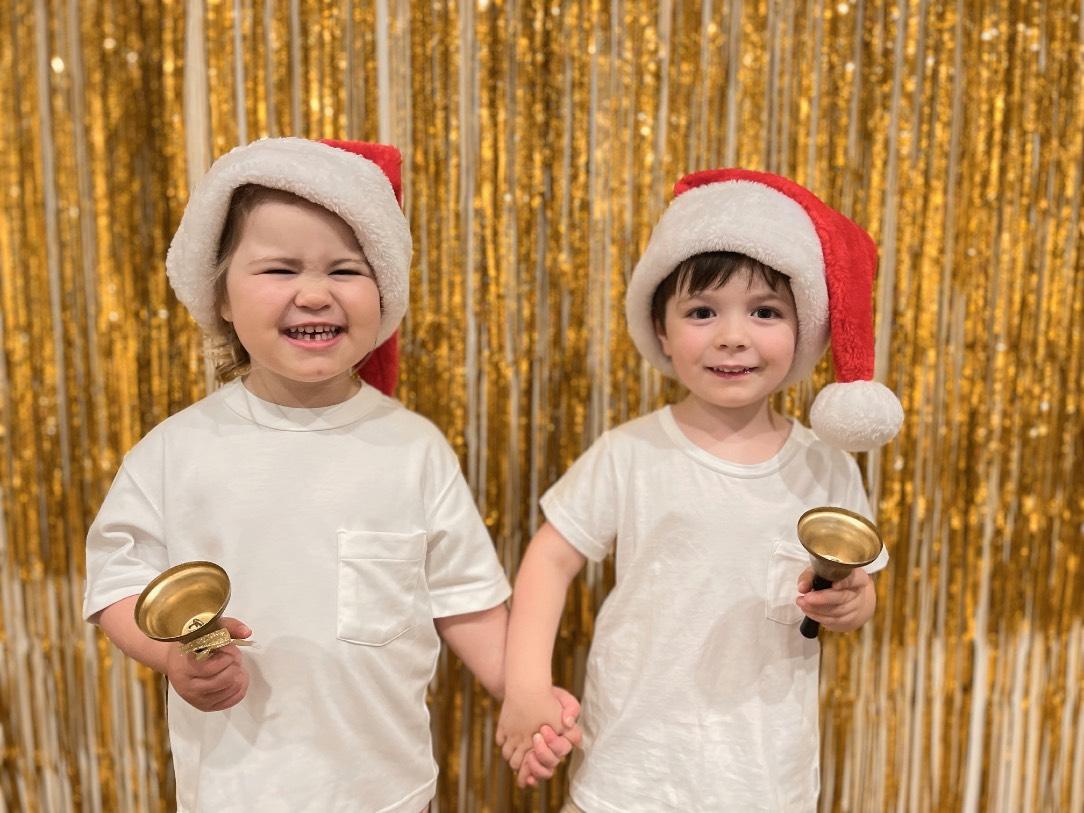
REDDAM EARLY LEARNING SCHOOL | ST LEONARDS NEWSLETTER
24th February 2023
1
REDDAM EARLY LEARNING SCHOOL ST LEONARDS NEWSLETTER
Principal’s Message Continued…
At Reddam, our children are provided with many opportunities to work through their ideas and understand the world through a variety of representations, through painting, sculpting, constructing all the time building on their individual interests as expressed through the learning provocations that they choose.
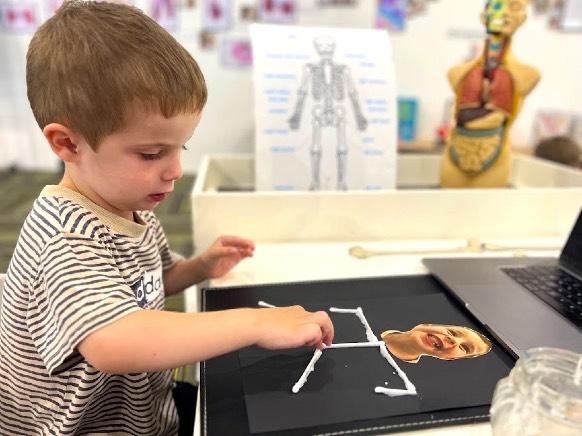

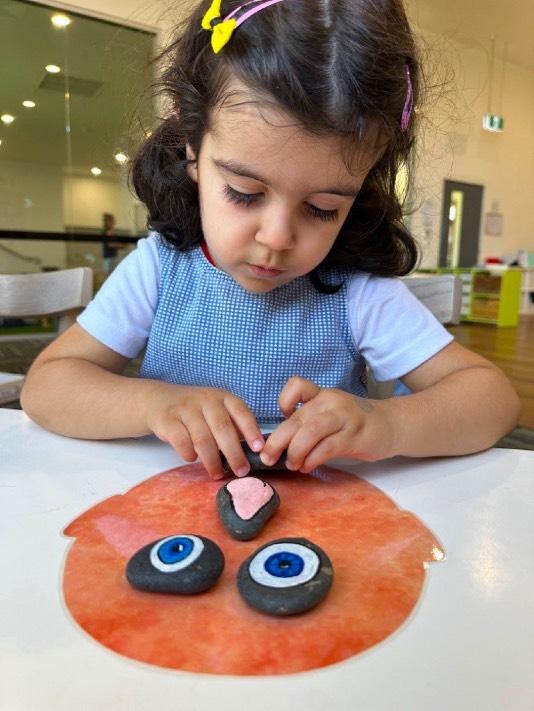
We want our clever, capable children to recognise their full potential and see themselves as the inventors, authors, artists, storytellers and scientists that they are, Supporting them to build confidence and self-esteem that ensures they are limited only by their imagination.

REDDAM
SCHOOL
EARLY LEARNING
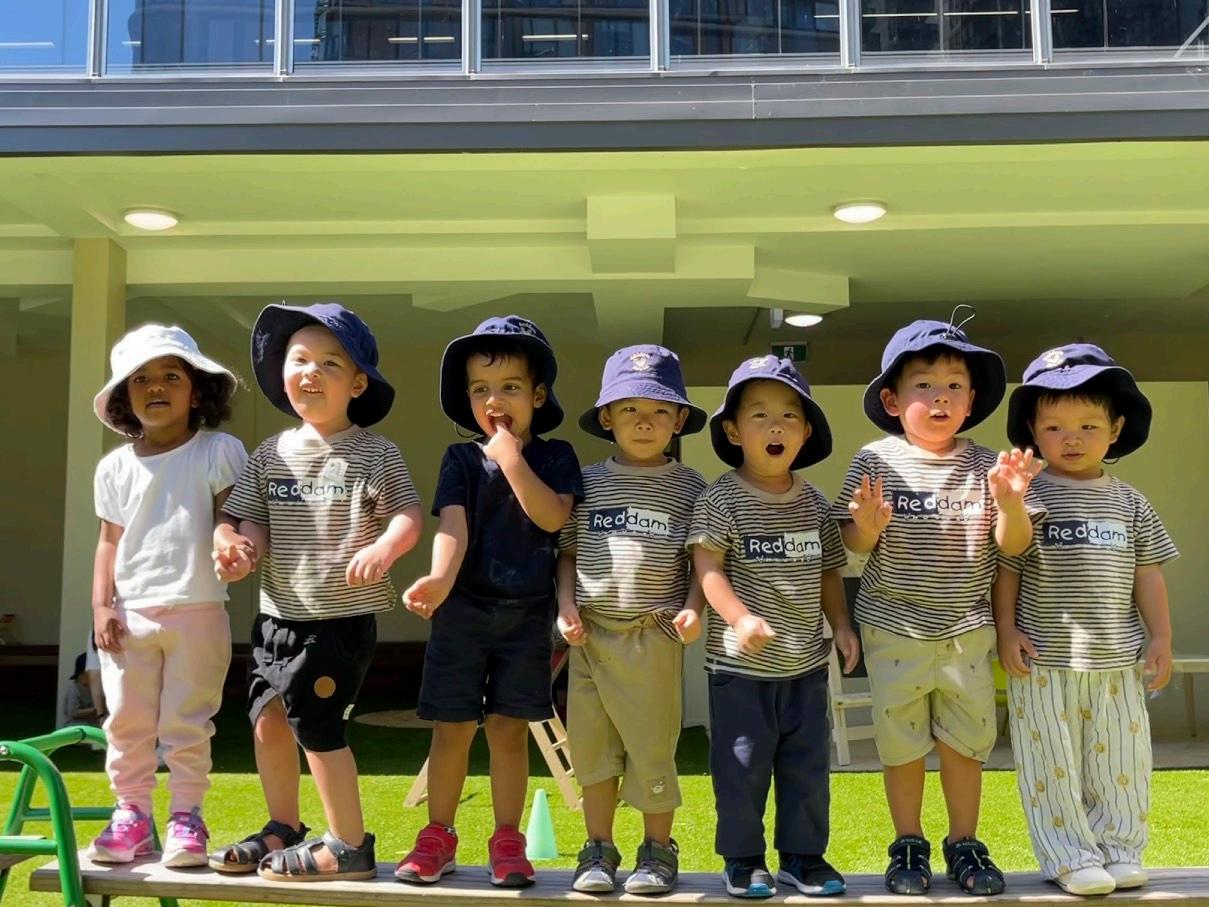
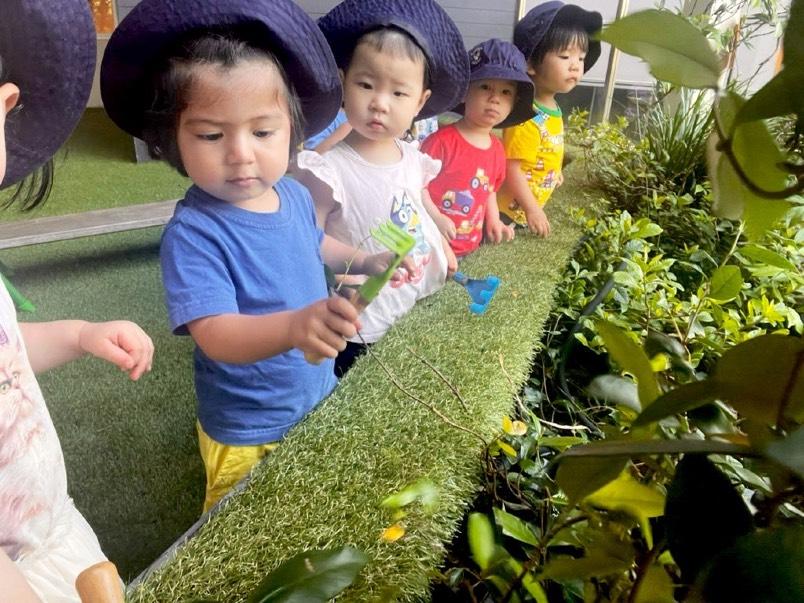
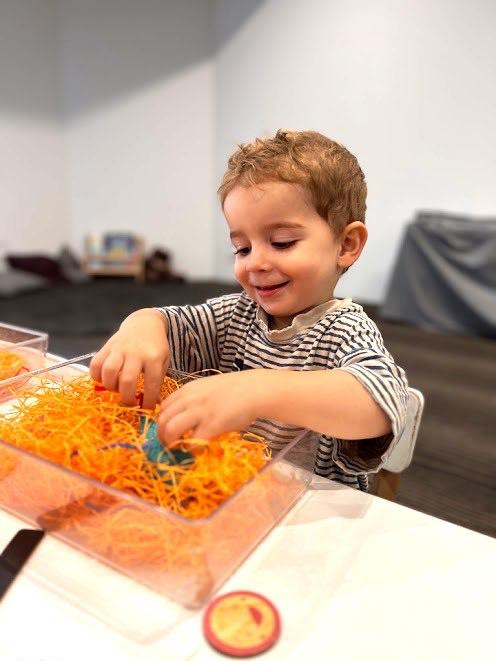

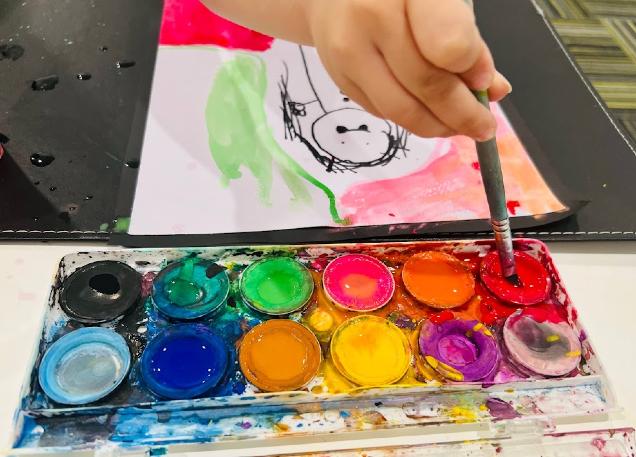
REDDAM EARLY LEARNING SCHOOL | ST LEONARDS NEWSLETTER 3
Stage 4R
Under Water World – Food Chains
By Ms Riina Andrews
This week, we explored Ocean Food Chains. The children were all very interested in what sea animals eat, as we were feeding our pet fish. “I know what sharks eat” exclaimed Ella, “people!”, hence a new question to explore was created.
Firstly, we watched a visual representation of Ocean Food Chains and how this related to the eco-system of the ocean.
The visual representation explained that:
- A food chain shows how each living thing gets food.
- Living things need nutrients to survive and they get this in different ways.
- Some animals eat plants and some animals eat other animals to survive.
- Food chains begin with plant-life which can create its own food through photosynthesis.
We explored the key vocabulary associated with food chains as well as which sea creatures are predators and which are prey.
The most prominent information that the children gained from this experience was:
- Learning more about the fascinating creatures that live in the ocean, what they eat and how they have adapted to survive.
- Learning about the relationship between plant life, predators and prey and how they live in harmony in the delicate ecosystem.
- Gaining a greater understanding of Science, the natural world and this Under Water World topic
And the secondary concept of learning about food chains was:
- The animals at the top of the food chain are apex predators, such as wolves, lions, and human beings.
- Apex predators are not the natural prey of any animal and consume smaller animals for energy. Apex predators hunt and eat prey animals, which are normally herbivores.
- Herbivores sit near the bottom of the food chain as their only source of nutrition is plant life.
- Herbivores such as rabbits and gazelle are often prey for larger animals.
Art and Craft Lesson
To foster the above topic, we created our own Ocean themed Food Chains. Using the technique of observational drawing, the children drew and then painted, individual cards of the food chain and connected them together using pipe cleaners for a mobile display.
Next week, following on from the children’s interests, we will be exploring the concept of ‘How do we to keep our Ocean Clean?’
REDDAM EARLY LEARNING SCHOOL | ST LEONARDS NEWSLETTER 4

Stage 4R: Food Chains
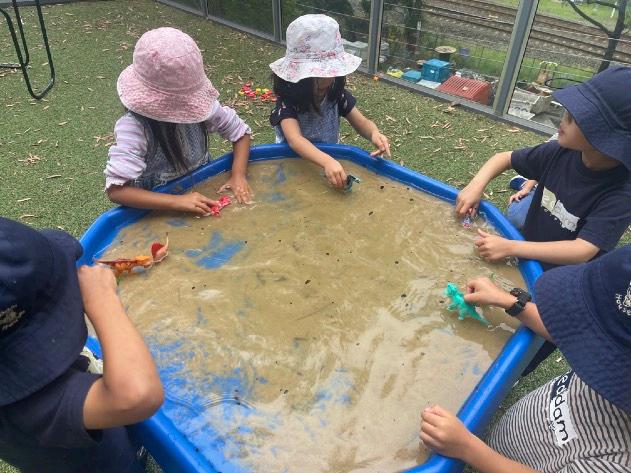

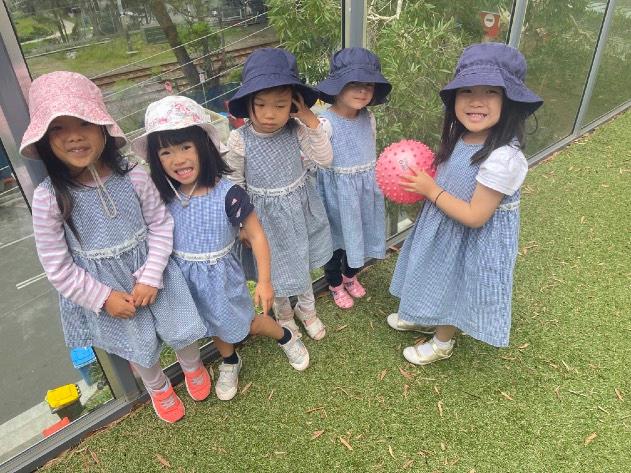
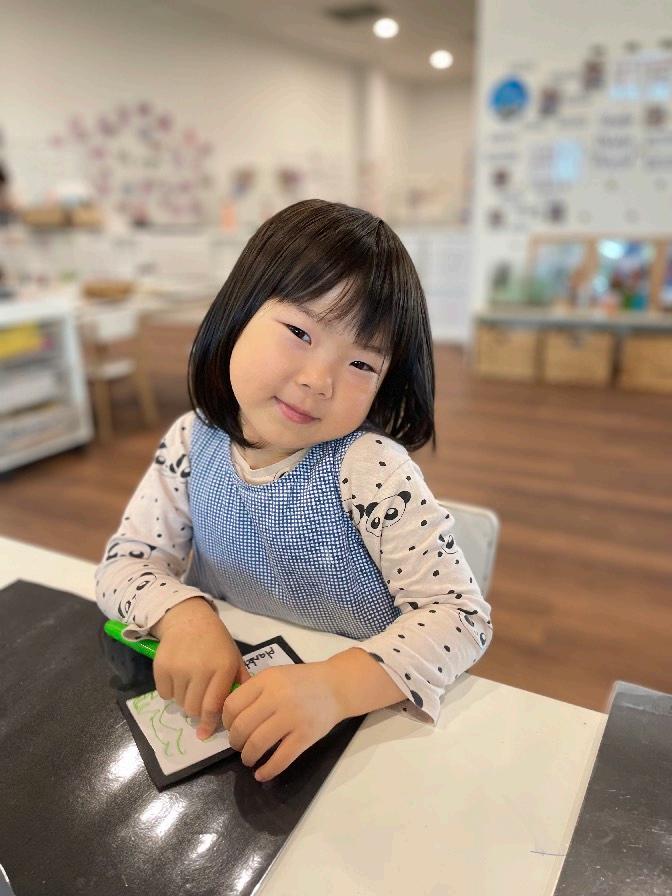
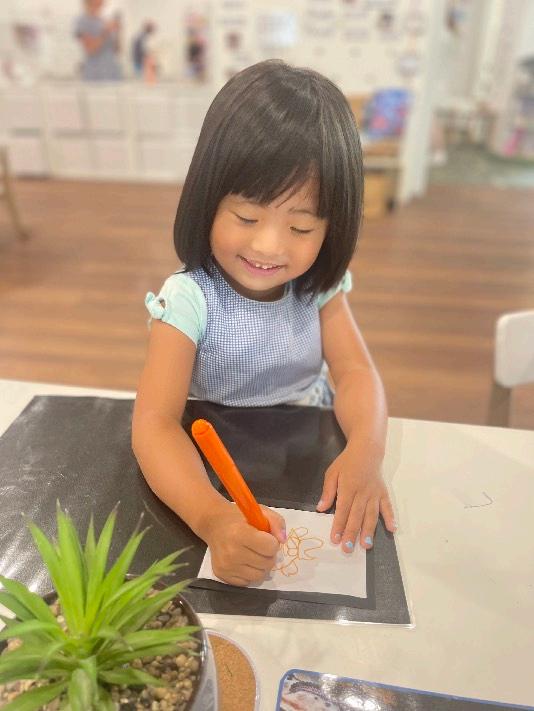
REDDAM EARLY LEARNING SCHOOL | ST LEONARDS NEWSLETTER 6
Stage 4R: Sea Creature Sculpture
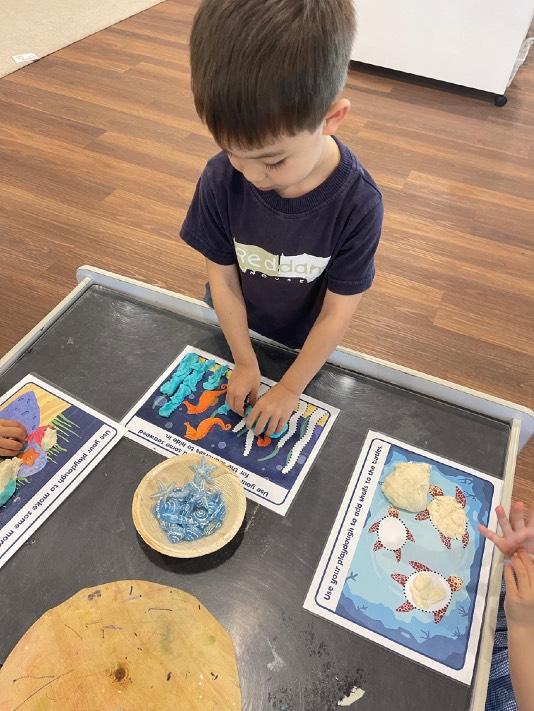
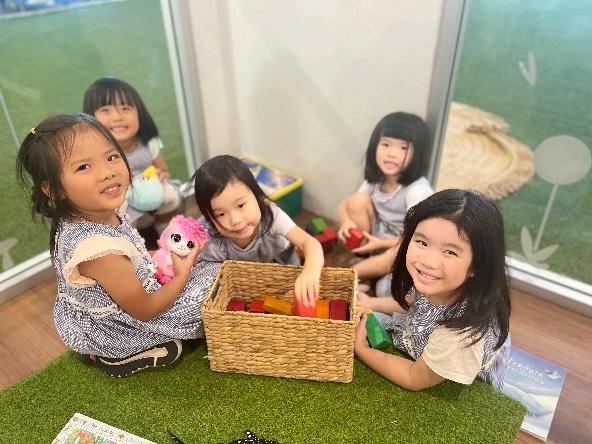
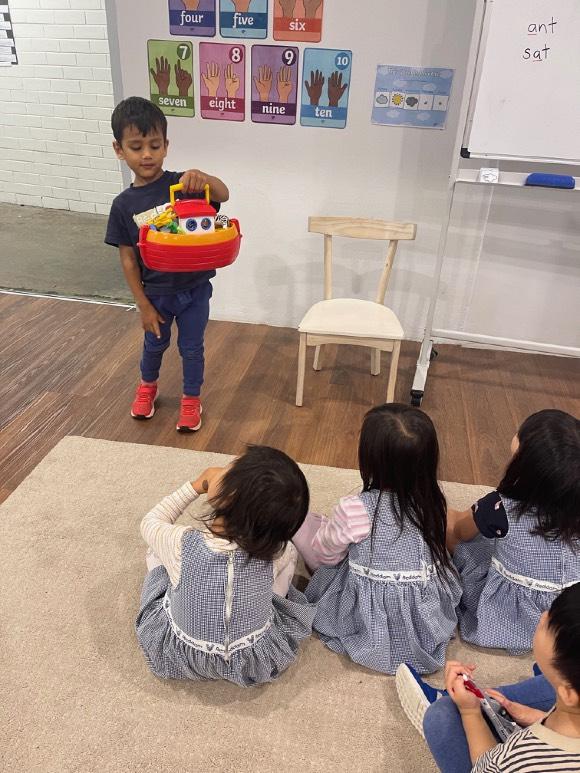
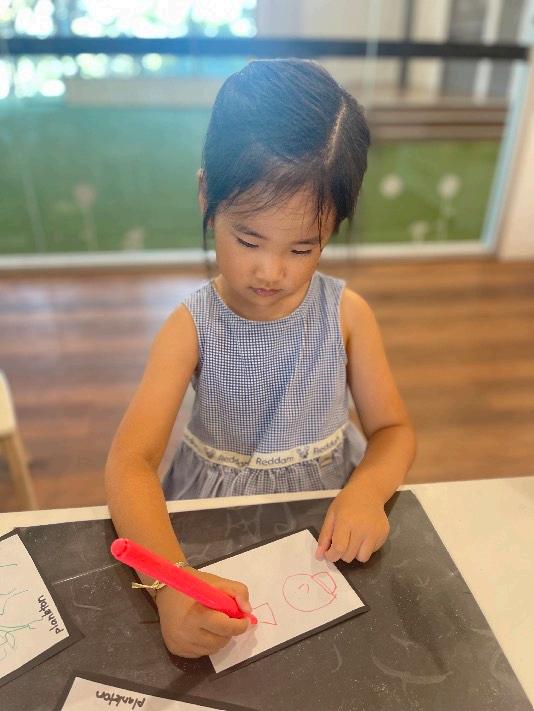

REDDAM EARLY LEARNING SCHOOL 7
Stage 4E
The Skeletal System
By Ms Emily Brazel
As an extension from the previous weeks provocation; “The body organs”, the children have shown and begun to ask questions about their bones. This came about when Milo came and and told his teachers he had broken his ankle bone. This sparked conversations around keeping our bones healthy so they do not break.
We began the week with a group discussions this week about the importance of keeping our bones strong and ways we can keep them strong. Some responses included:
- Annabelle B- “Eat healthy food”
- Annabelle S- “You can go to the gym”
- Caelie- “Eat lots of vegetables”
Following on from these discussions teachers decided to teach the children a song about the bones and how they are all connected. This song was called “Dem dancing bones”. This encouraged the children to learn about the different bone connections in the body in a fun and exciting way.
Where does each bone belong?
Before we set to work as a group we had a discussion about the various bones in their body and where they are located. After this discussion the children then put on their thinking caps and set to work. They were asked to think back to what they had learnt for the week and recreate the skeletal system using the large bones. Each child had the opportunity to show their friends and teachers that they have been listening and learning throughout the week and able to put each bone in the correct spot on the body. The children were encouraged to help each other and talk to their friends if they needed assistance throughout the process. It was lovely to hear the authentic conversations taking place throughout the activity. Great job Stage 4E!
Bone to be wild
Learning about the human body's skeletal system and making it come alive with these cotton swab skeletons is a fun way to learn about bones. Firstly each child was asked to show us their wild, funny faces. Once that was complete, teachers cut it out and stuck it on black paper. For this individual activity teachers asked children to firstly use their imagination to create a blueprint of their skeletal system using the cotton buds. Once they had placed each cotton bud down where they wanted their bone to be they used the PVA glue to stick it on one by one, practising their fine-motor skills and hand-eye-coordination. This was a great way to talk to each child individually about where the bones in their body are located. It allowed them to practise their creative and imaginative skills.
Let's create a skeleton
This week the children were invited to participate in a painting activity that encouraged them to practise their hand eye coordination, fine-motor and creative skills, whilst using a skeleton picture as a visual stimulus. This experience involved black paint, white paper and a fine tip paintbrush. The children showed great language and communication ability throughout this experience as they sat next to each other and articulated the human body.
REDDAM EARLY LEARNING SCHOOL | ST LEONARDS NEWSLETTER 8
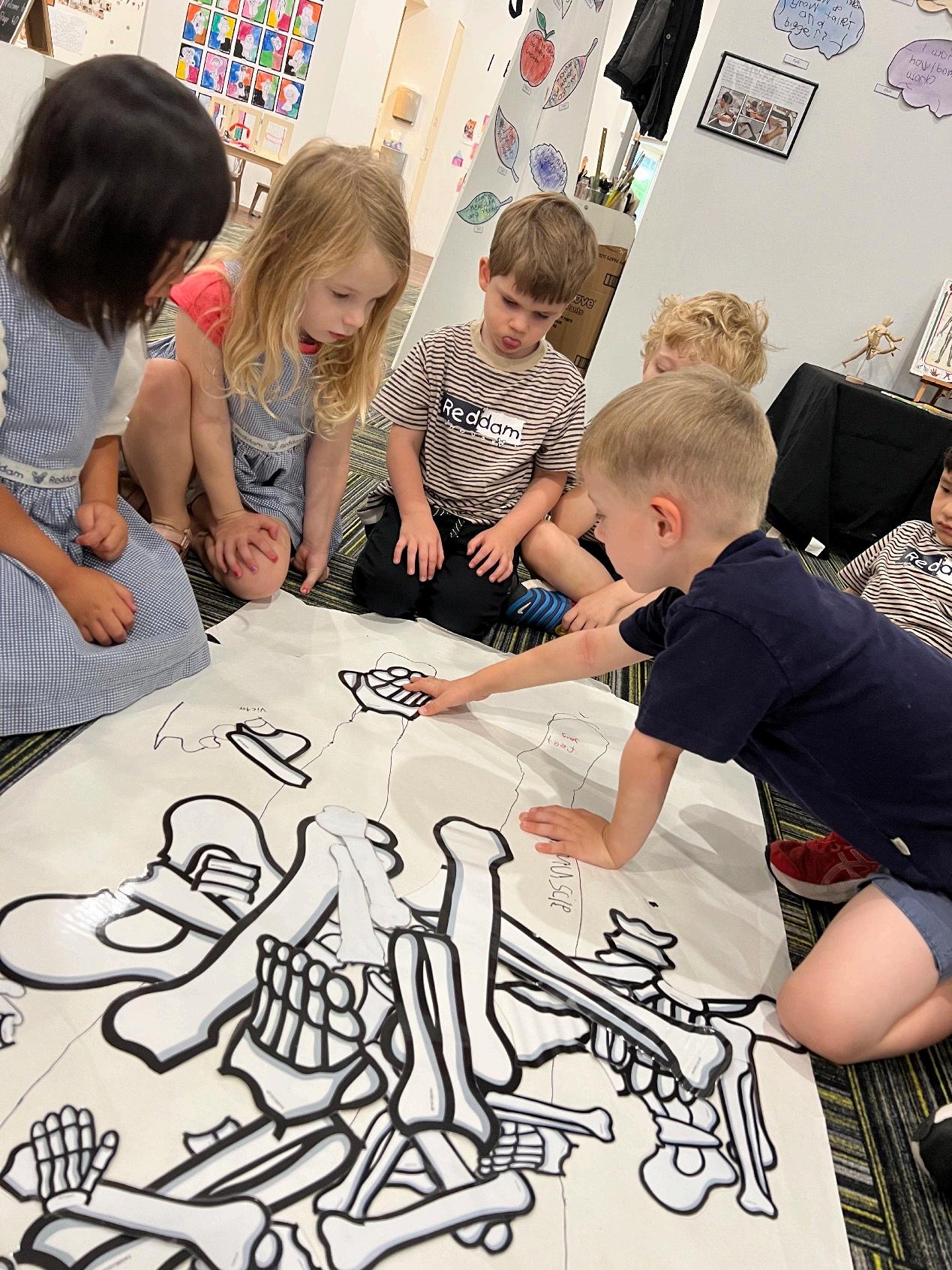
Stage 4E: Bone to be Wild!



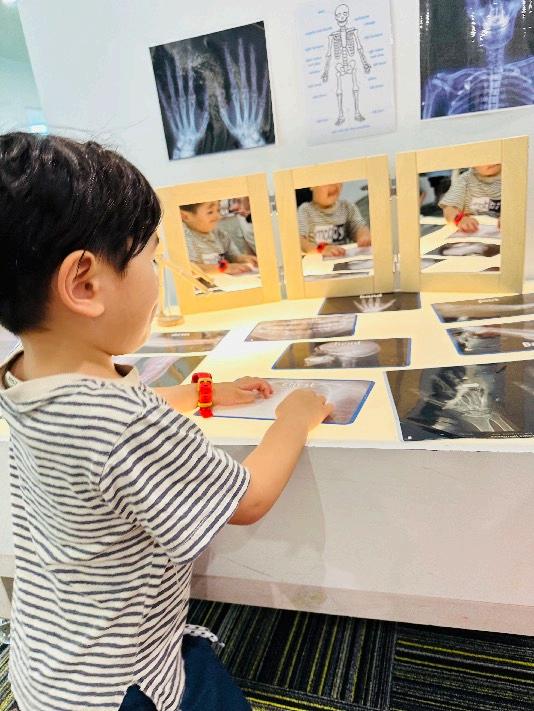

REDDAM EARLY LEARNING SCHOOL | ST LEONARDS NEWSLETTER 10
Stage 4E: Creating a Skeleton
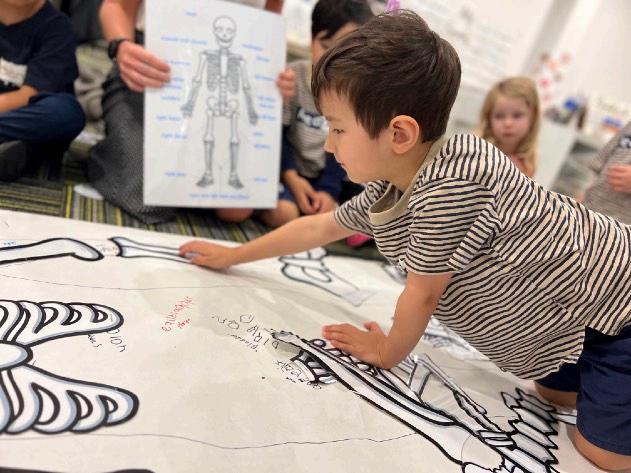
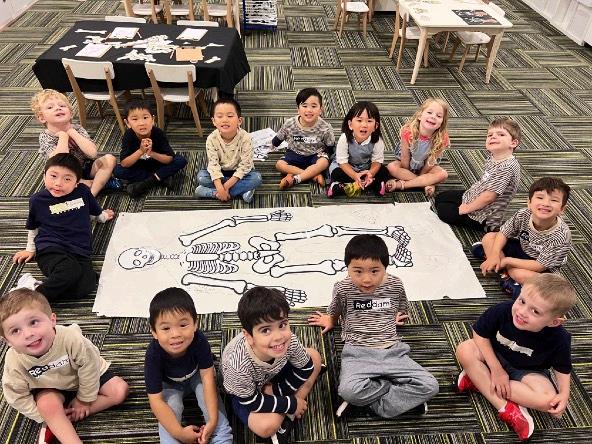
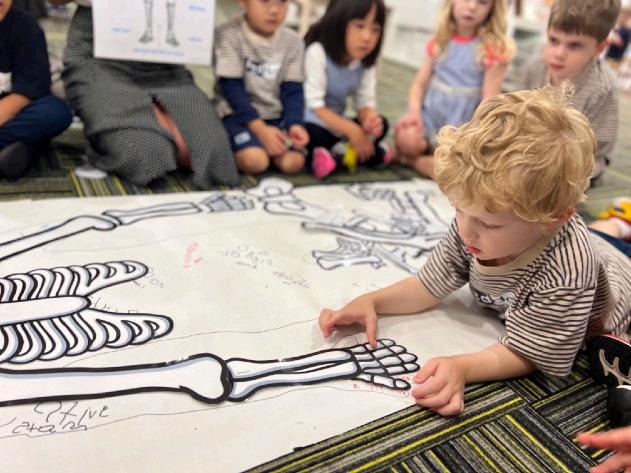
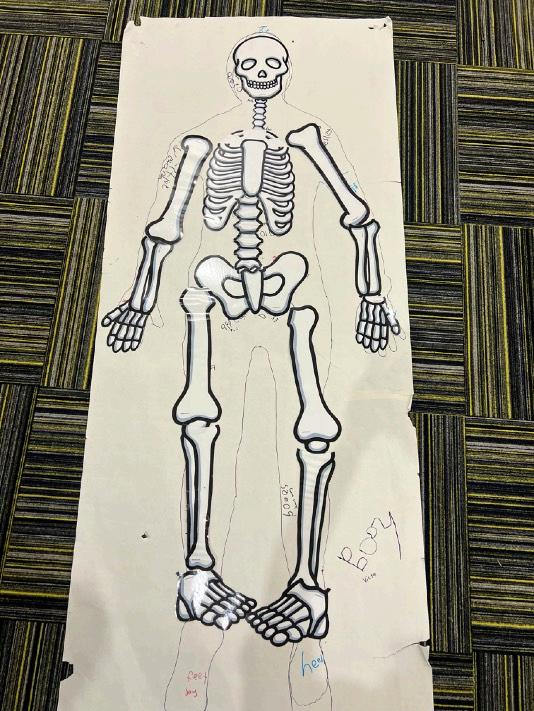
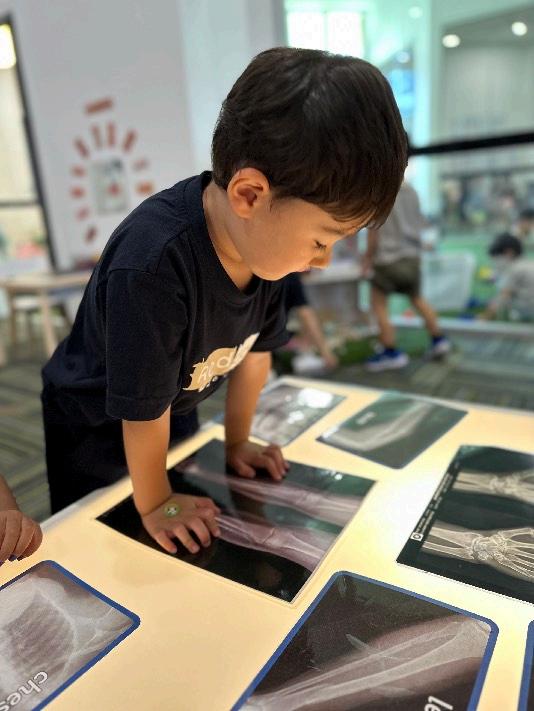
REDDAM EARLY LEARNING SCHOOL | ST LEONARDS NEWSLETTER 11
By Ms Sarah Ross
Where Does Bread Come From?
This week Stage Four embarked on an investigative journey to find out where our bread really comes from. We began with exploring some texts including ‘The Little Red Hen’, ‘The Journey of Bread’.
Each text followed the process beginning with the soil being cultivated, wheat seeds being sown into the ground, to being harvested, the grain milled into flour, and then the flour being used to bake bread. The children were intrigued to learn how detailed and lengthy the process is.
Baking Bread
To extend upon what we learnt in the two texts above the children were invited to bake their own bread. First, we held a discussion about what ingredients we need, and the responses included ‘flour’, ‘water’, ‘butter’ and ‘salt’.
As a class the children took turns helping to add and incorporate the ingredients starting with salt and flour and then rubbing the softened butter into the flour with our hands. Next, we added the water and mixed with a spoon until it was time to knead the dough.
Once our dough was shaped and in the baking tray, we transported it to our kitchen for Chef Caleb to bake in the oven. Stage Four were filled with excitement once our bread had returned from the kitchen and immediately noticed the changes in texture and lovely smells coming from our freshly made bread.
For our afternoon tea we sliced up our warm bread and served it with butter and sprinkles.
Drawing Tractors
Following our discussions of the text ‘The Journey of Bread’ many of the children expressed their interest in exploring vehicles and machines used for farming. This led to a reading and viewing of the text ‘Machines on the Farm’ which explored machinery including tractors, combine harvesters, industrial sprinklers, balers and many more.
To extend upon this further the children were invited to engage in a drawing experience where they followed a sequence of events to create their own tractor using black markers and colourful crayons. This experience instilled so much confidence and pride in the Stage Four children as many were amazed that they could draw what seemed to be a complex drawing. Each child demonstrated their ability to attempt new and challenging tasks and persevere to achieve their goals.
“Children’s active involvement changes what they know, can do and value and transforms their learning and thinking”
Stage 4D
– Early Years Learning Framework
REDDAM EARLY LEARNING SCHOOL | ST LEONARDS NEWSLETTER 12
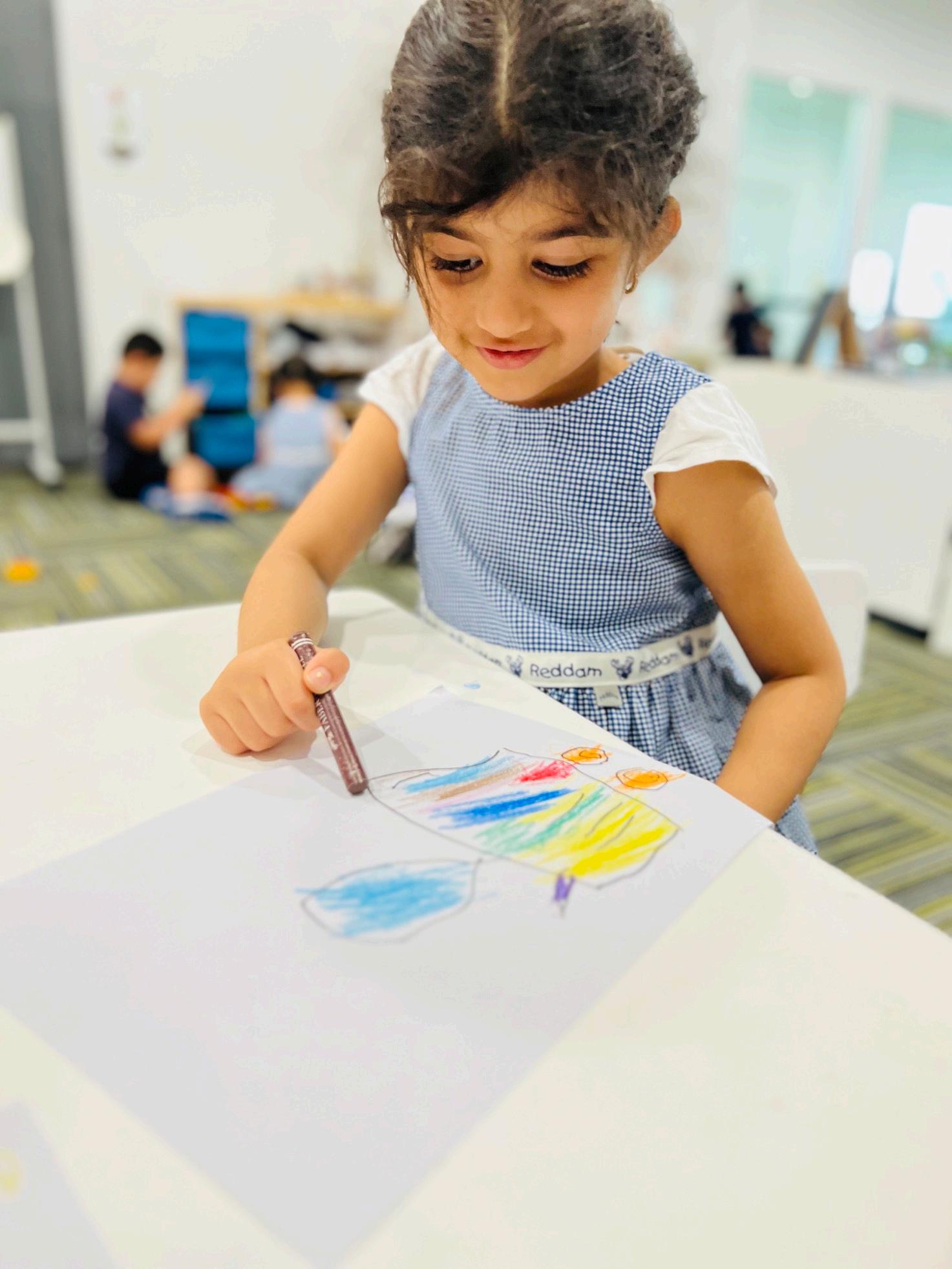
Stage 4D: Baking Bread

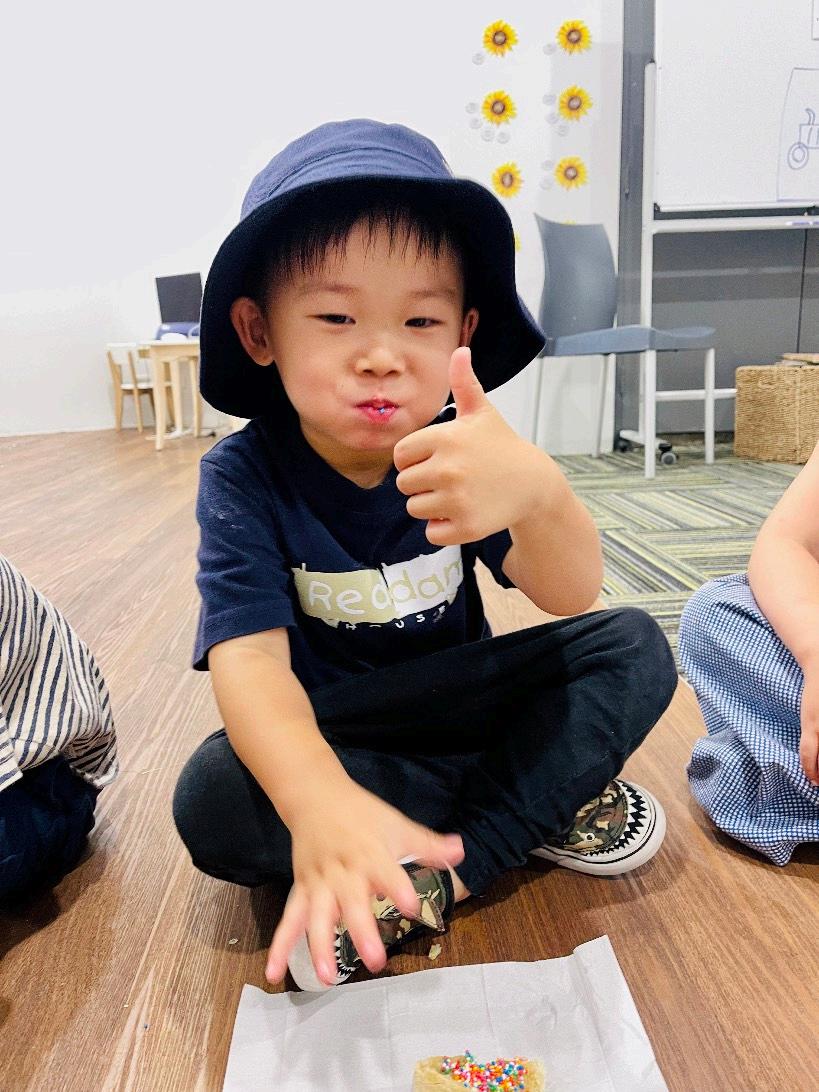
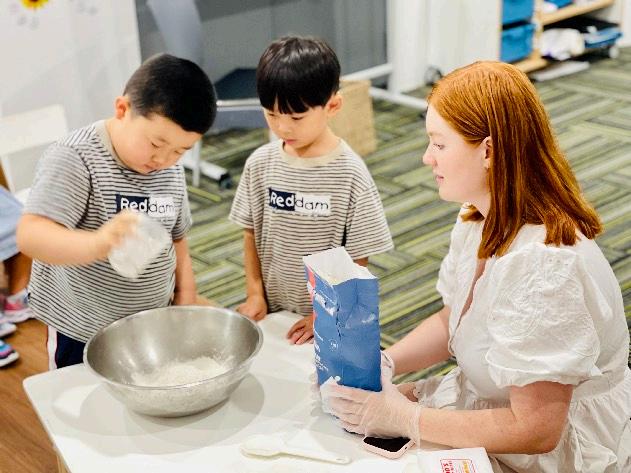
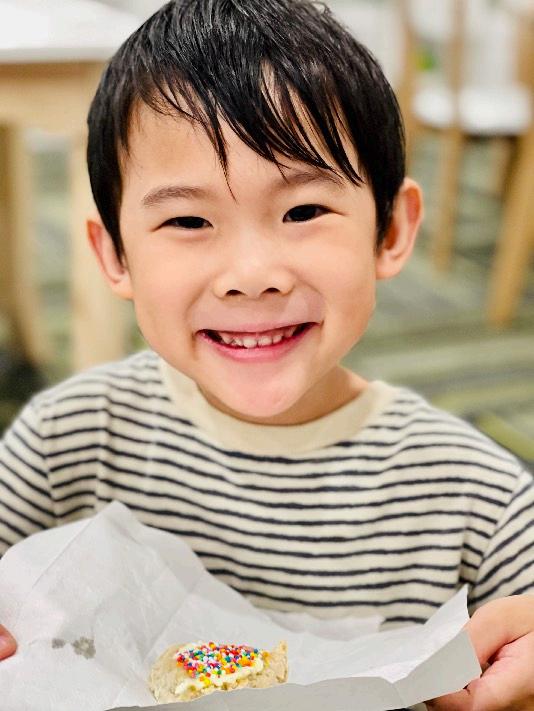
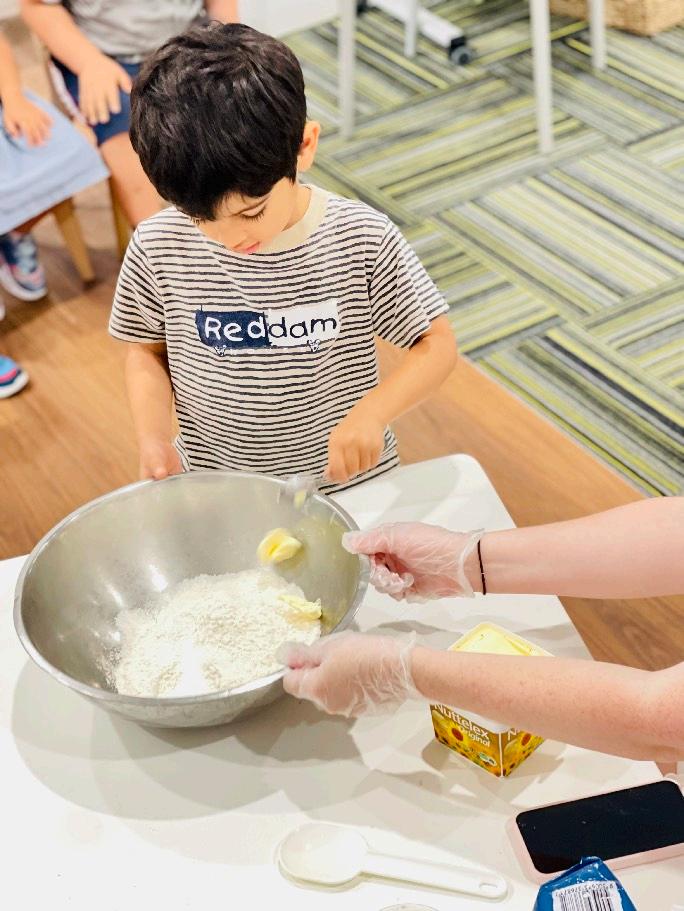
REDDAM EARLY LEARNING SCHOOL | ST LEONARDS NEWSLETTER 14
Stage 4D: The Journey of Bread
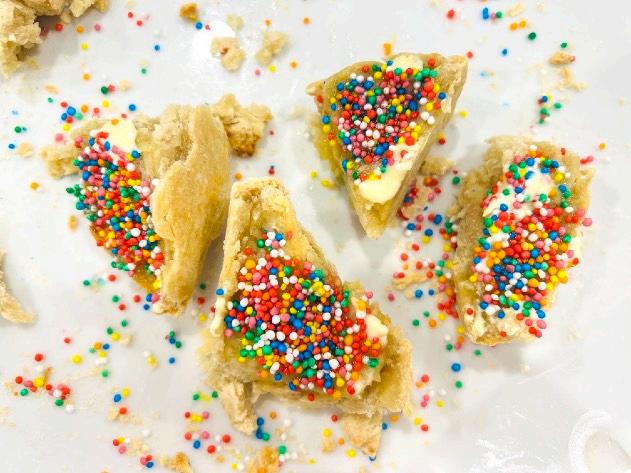
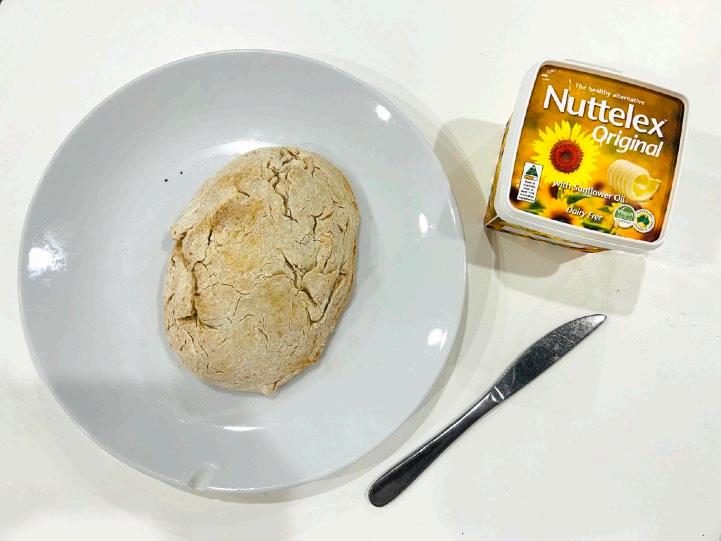
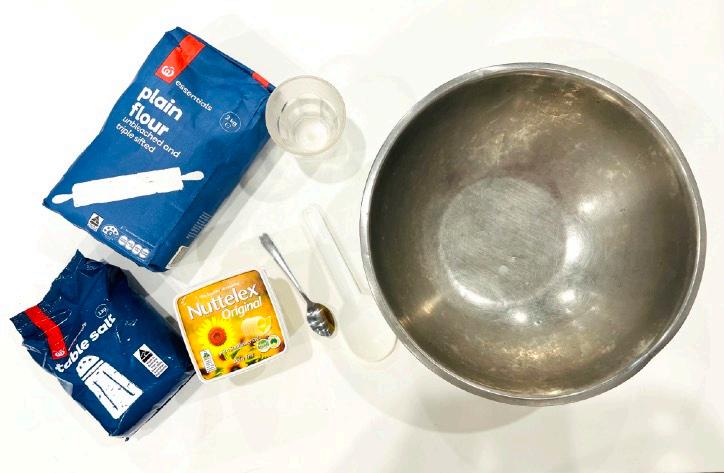

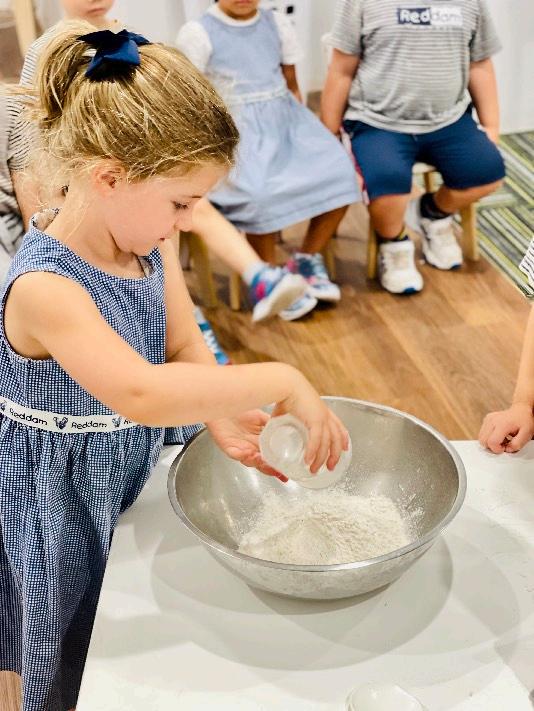
REDDAM EARLY LEARNING SCHOOL | ST LEONARDS NEWSLETTER 15
By Ms Emily Chacon
I Am Healthy
This week we have begun exploring aspects of being healthy, both inside and out. We gathered to create a mind map of the children's understanding of keeping healthy, some ideas were:
Harrison - "eat vegetables"
Gemma - "eat fruit"
Arush - "Wash your hands"
Amelia C - "do exercise"
Olivia - "eat healthy foods"
Madeline - "run around"
Charlie - "brush your teeth"
As a class session we explored germs! To introduce the area we read a book on germs called ‘What are germs?’.
This book took a closer look at those mischievous, microscopic bacteria and viruses, and opened for question and answers from the children.
How do germs spread?
How can we stop the spread?
Following on from this, the children were asked to pair up and one partner to put their hand into the glitter bowl. The glitter was to represent the germs that are on our hands, after giving their partner a high five they were asked to look at their hands to see what happens. “The germs have spread” everyone answered. After everyone washed their hands with soap to stop the spread of their germs!
At our table activity the children were invited to practice setting the table. A plate, cutlery, cups and food were available for the children. Using a guiding placemat, the children were able to place all the utensils in their correct position. Then using the tongs, they could serve themselves flood and engage in pretend play.
This experience further develops the children’s fine motor skills as well as engaging them in imaginative and confidence building play.
Next week we will be further exploring keeping HEALTHY in the foods we eat and keeping a balance of foods and exercise.
Stage 3/4
REDDAM EARLY LEARNING SCHOOL | ST LEONARDS NEWSLETTER 16

REDDAM EARLY LEARNING SCHOOL | ST LEONARDS NEWSLETTER 17
Stage 3/4: How Do Germs Spread?
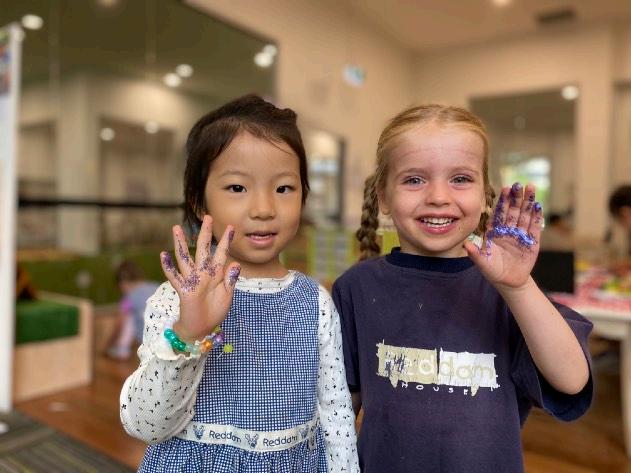

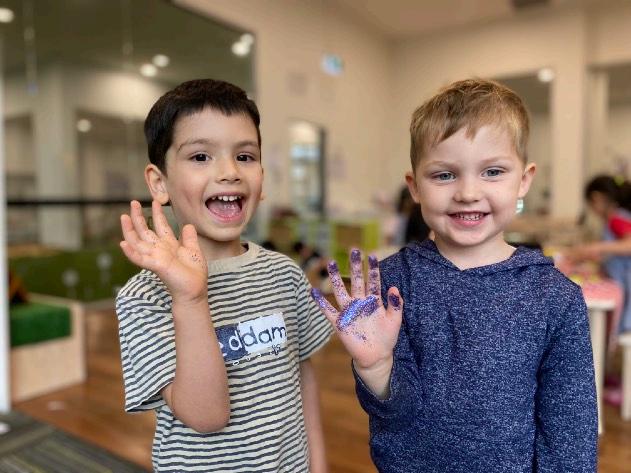
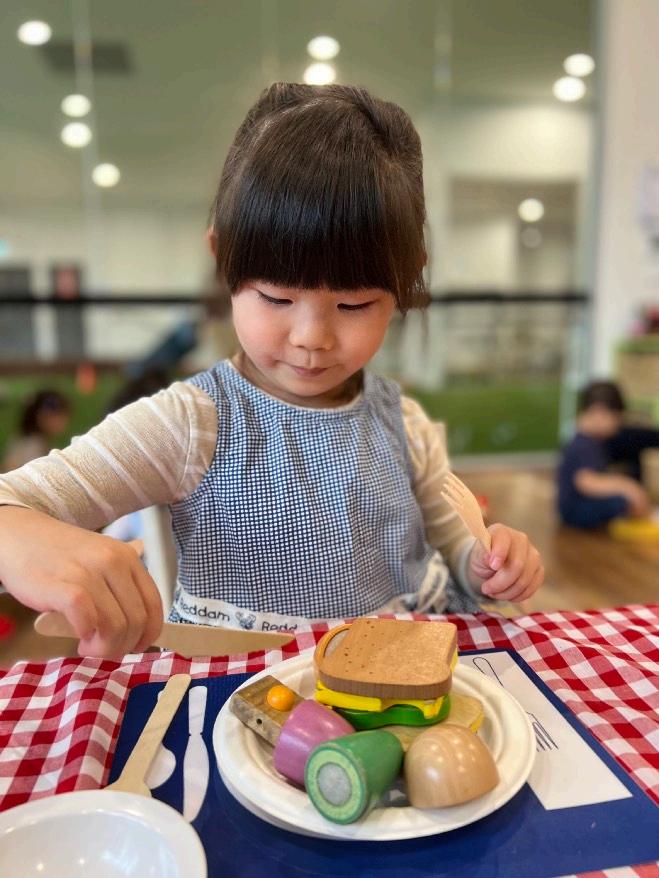

REDDAM EARLY LEARNING SCHOOL | ST LEONARDS NEWSLETTER 18
Stage 3/4: Healthy Eating


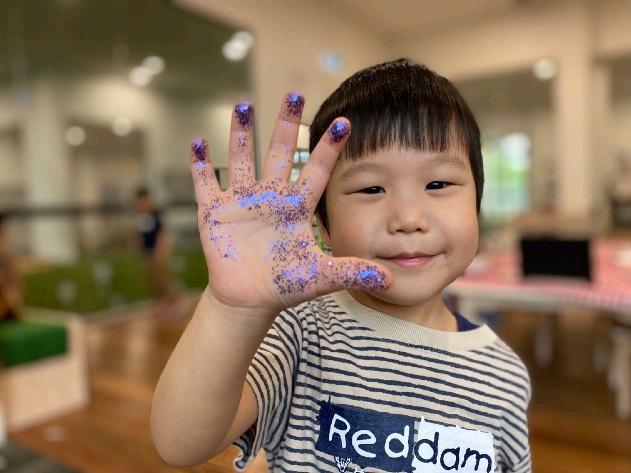
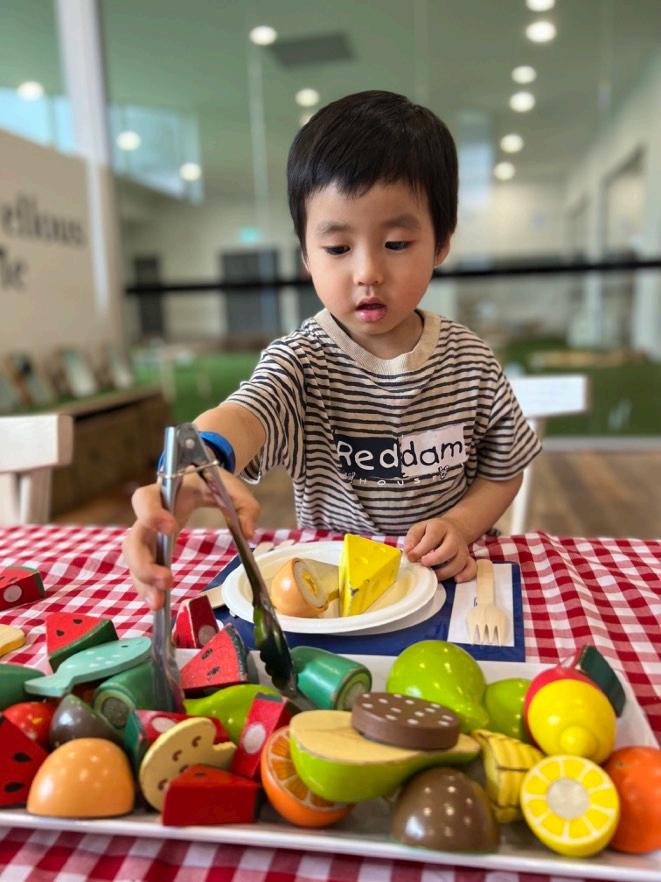

19
Stage 3E
By Ms Amy Ahmed and Ms Carolina Machado
How I See… My House
Last week the children explored the importance of families, and this week we extended this to look at our houses! Our houses are more than just the places we live, they are where we come together with our families, where we feel most safe and comfortable, and most importantly, the place we call home.
The first table activity was a STEM project that asked the children to use their critical thinking skills. They were tasked with constructing scaffolds using straws, with playdough to hold it all together. They quickly figured out that the playdough could help the straws stick together, but that too much was too heavy and their houses would fall down!
Their art project was creating a minimalist house collage using coloured paddle pop sticks. They carefully placed the sticks into the glue, and were asked to explain what they were creating: did this stick represent the walls, floor, roof, or something else?
The children loved the small world play set up, where they found miniature people and cars, with customisable building blocks so they could create their own houses and neighbourhoods.
During group times the children were asked to share their thoughts on their houses. The conversation was open ended, and it was wonderful to see the variety of thinking processes and imaginative thoughts they had. Some focused on who lives in their house, or what items they had, while others on what their house looks like. Others had more abstract thoughts, describing the attributes of houses in general, or of houses stemming from their play and imagination:
“My mummy and daddy and my Jayden and grandpa live in my house” - Mia
“I’ve got a house for Georgie and Mummy and Daddy and Me” - Bella
“My house is big and we drive to the swimming pool” - Xander
“My house has my room and my toys and kitchen!” - Arthur
“A house is made of a square and a triangle” - Leonardo
“My house is grey and it looks like a house” - Gabriel
“I have a Barbie Dream House!” - Claris
“In my house I have dinosaurs” - Liam
“I’ve seen a skeleton house!” - Aadi
We hope you have a wonderful weekend with your children, and look forward to next week where we will be exploring self expression and the children’s vivid imaginations for ‘How I See My Creativity’!
REDDAM EARLY LEARNING SCHOOL | ST LEONARDS NEWSLETTER 20
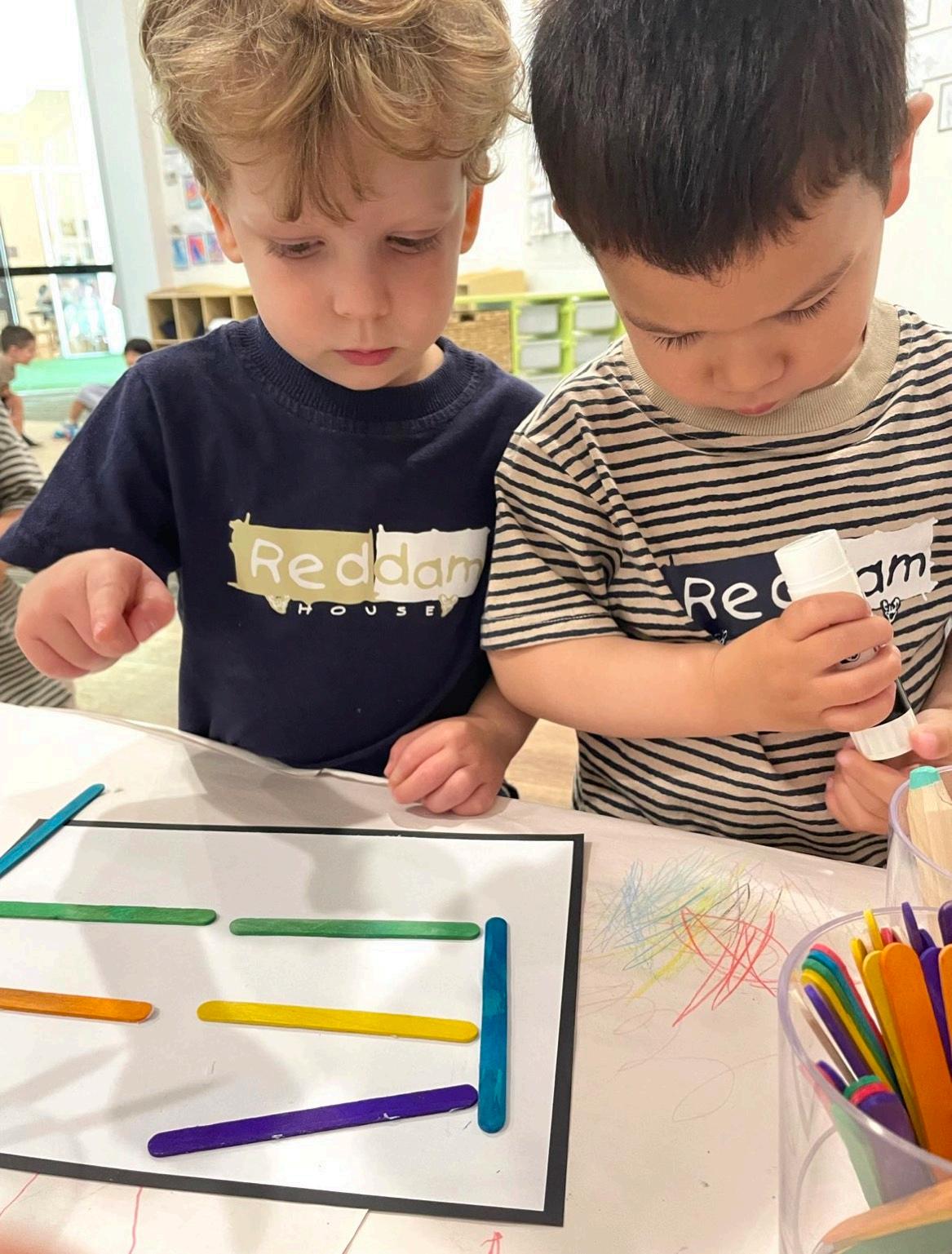
REDDAM EARLY LEARNING SCHOOL | ST LEONARDS NEWSLETTER 21
Stage 3E: How I See My House
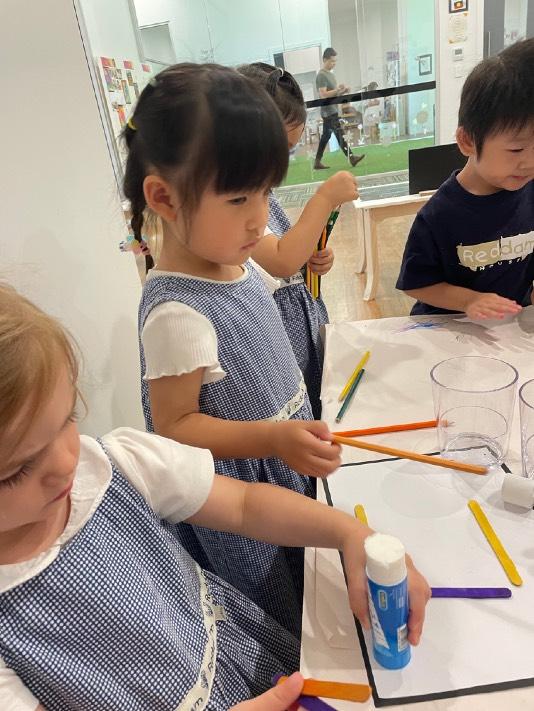

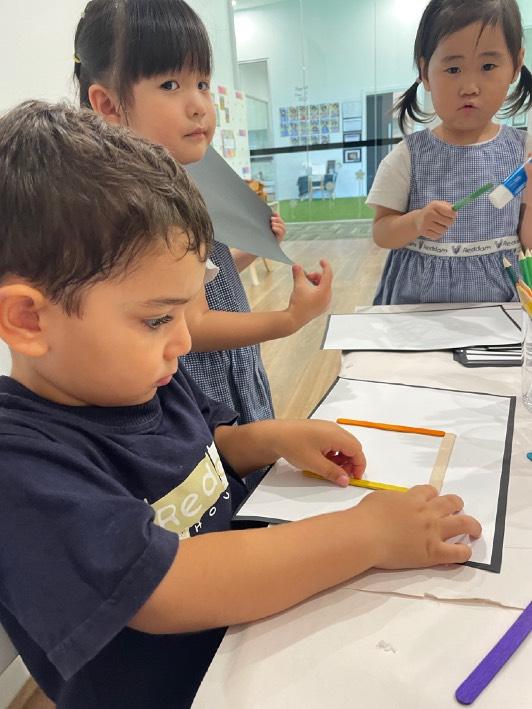


REDDAM EARLY LEARNING SCHOOL | ST LEONARDS NEWSLETTER 22
Stage 3E: Making Our Houses
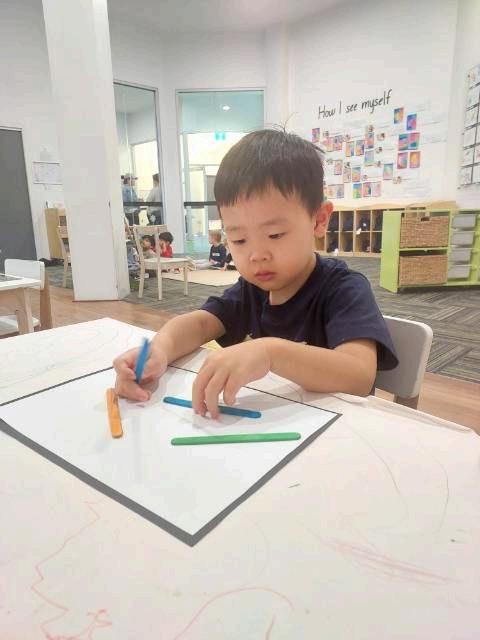


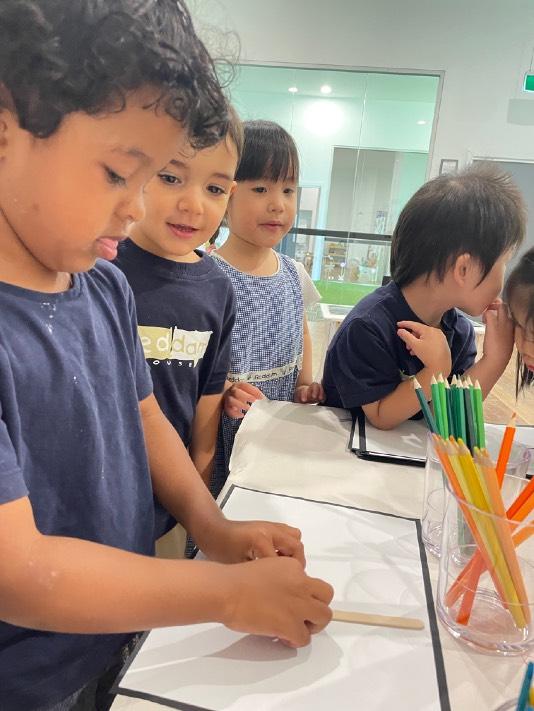

REDDAM EARLY
SCHOOL
LEARNING
Stage 2/3 and 3R
Emotional Intelligence
By Ms Gabriela Guimarães
For children, understanding their own and other people’s emotions can be a difficult and confusing thing. Emotional intelligence is a vital skill in a child’s development. Understanding feelings and motivators are an integral part of daily life and a more highly tuned emotional intelligence promotes empathy, social skills, self-awareness and emotional accountability.
Like all areas of development, we need to teach our little ones about emotions and how to respond to them as well, so they can develop healthy relationships with others, as they grow older.
This is where the Feeling Family Balloon Sacks come in. The concept behind these filled balloon stress balls is that although they are a family, they are all different. Different feelings and characteristics are associated with each one and were helpful for explaining emotions visually as well as being a conversation starter about feelings. We also went fishing this week, using handmade fishing rods the children were encourage to fish emotions.
During our group times we read a range of books about feelings and emotions. Our favourite books were “In my heart” and “Brave as can be” both by Jo Witek. In My Heart explored emotions: happiness, sadness, bravery, anger, and shyness. The book explained what an emotion feels like, physically, inside. Brave as can be explained that life can be full of frightening things: the dark, the neighbour’s dog, and thunderstorms, just to name a few. This playful portrait of fear and bravery empowered our children to confront once-scary situations.
This week the children have also being invited to make their self-portraits out of loose materials. A Self-portrait is an intimate, bold declaration of identity. During the activity the teachers gave the children a little bit of guidance and we introduced a new vocabulary of emotions such as happy, sad and angry. It was beautiful to see the children observing and then creating their self- portraits. Through the process they could explore their facial expressions and talk about their emotions.
When we can recognize and express our feelings, we can better manage our stress and improve our overall well-being. It is important to note that there is no right or wrong way to feel we reassure our children daily that is o to feel sad or angry, all emotions are valid, and it is important ti give ourselves permission to feel them.
In addition, it’s essential to understand that feelings are not permanent, and they can change and evolve over time. It’s ok to have good days and bad days, and it’s important to focus on the positive moments.
Teaching our preschoolers about feelings is an important part of their social emotional development. By using visual, storytelling, role playing, modelling healthy emotional expression, using positive reinforcement, and creating a safe space we can effectively teach our children about feelings and help them develop healthy emotional intelligence.
REDDAM EARLY LEARNING SCHOOL | ST LEONARDS NEWSLETTER 24

Stage : Fishing Emotions

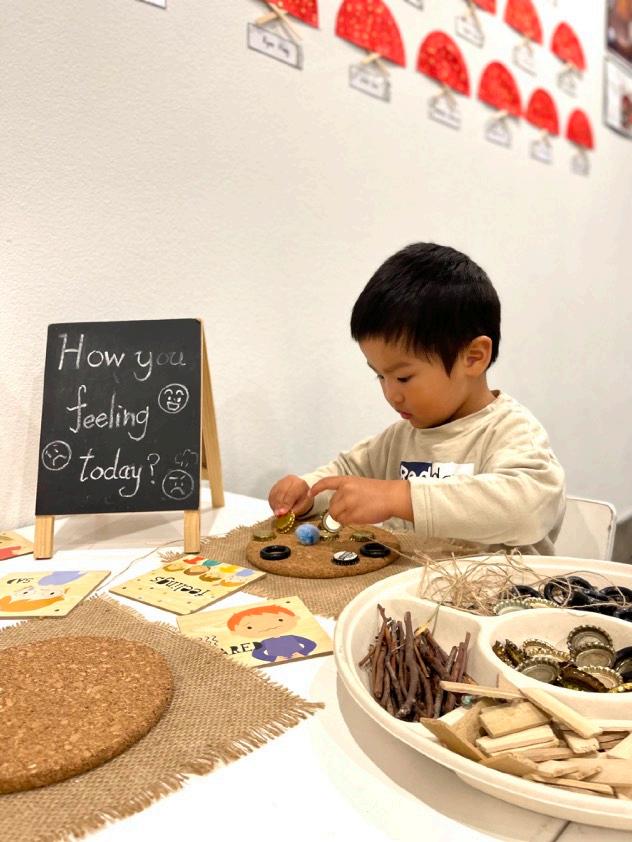
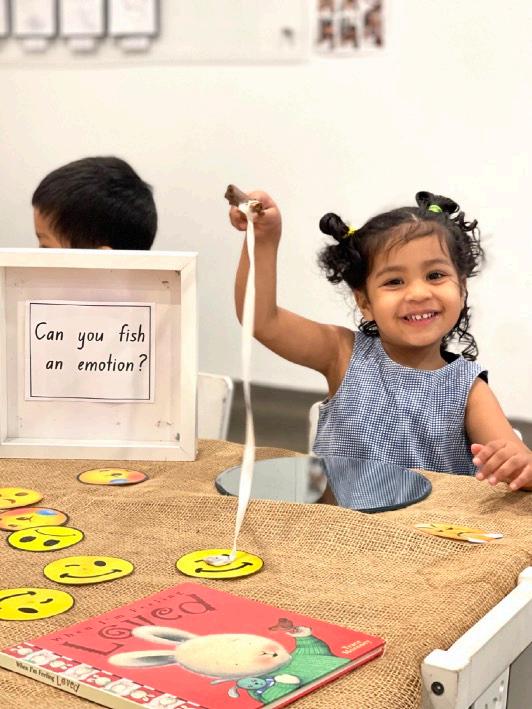

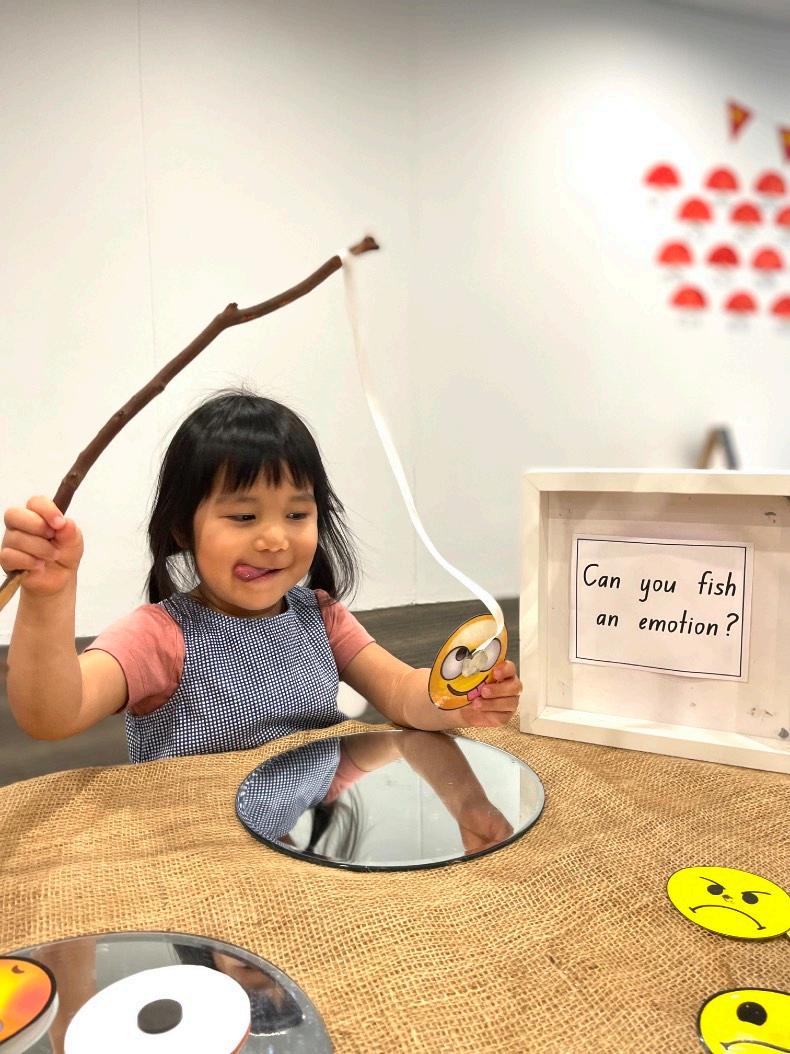
| ST LEONARDS NEWSLETTER 26
Stage 3R: Emotion Balloons

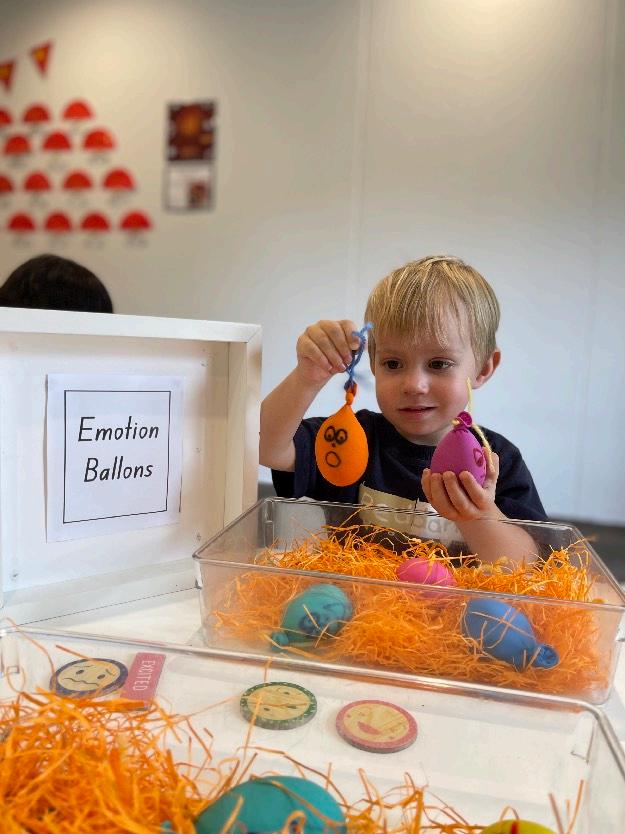
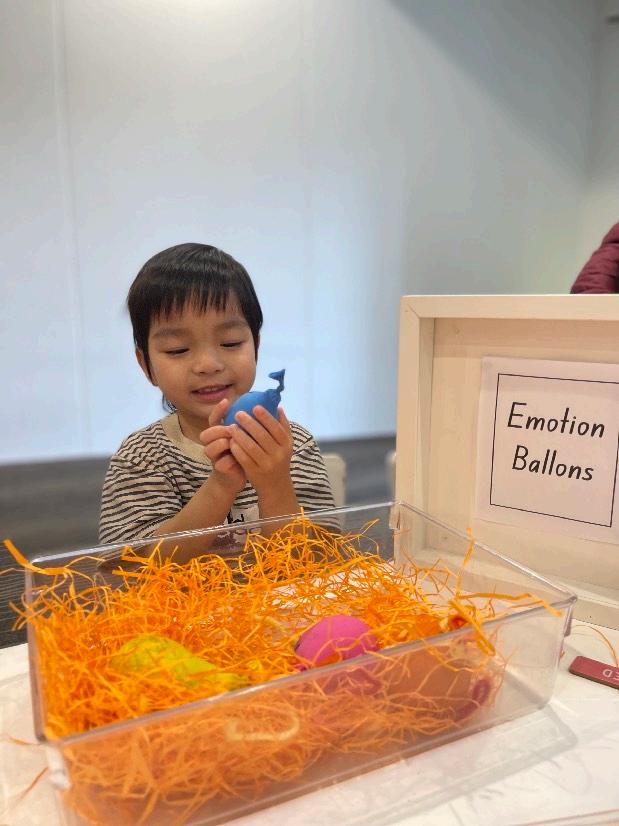
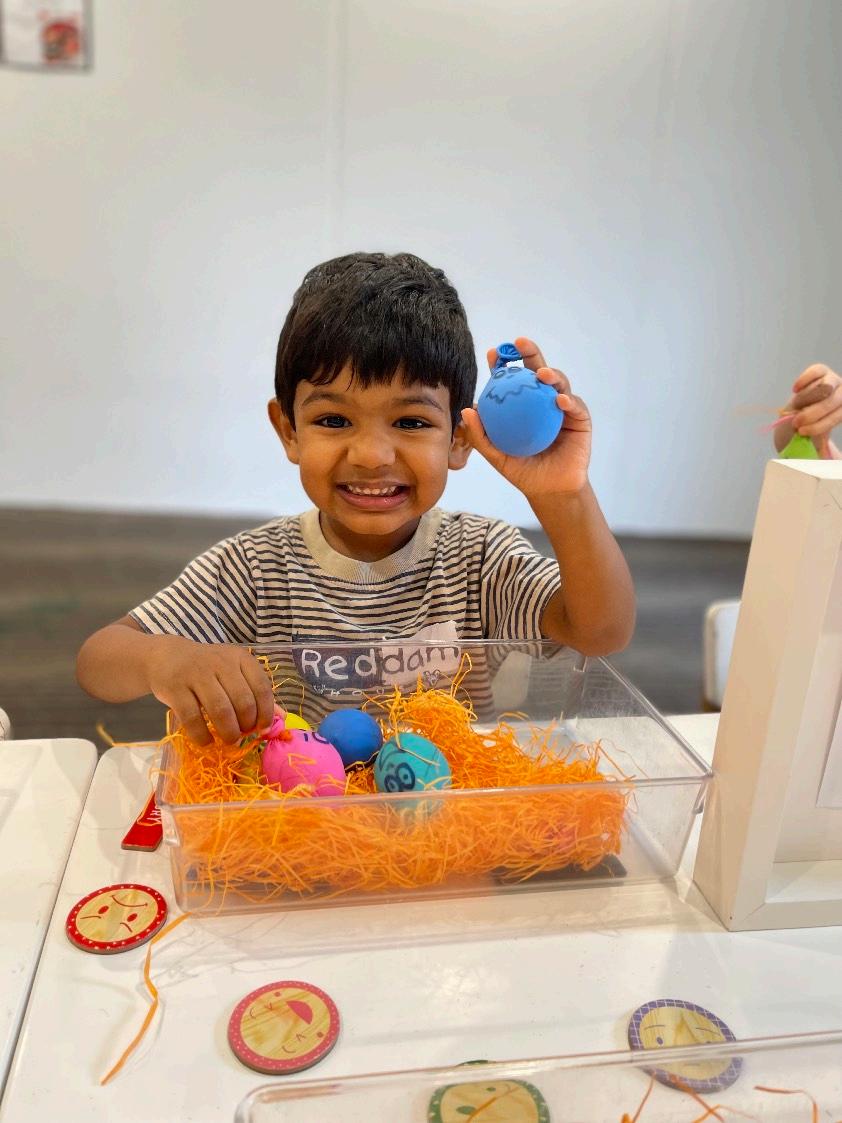
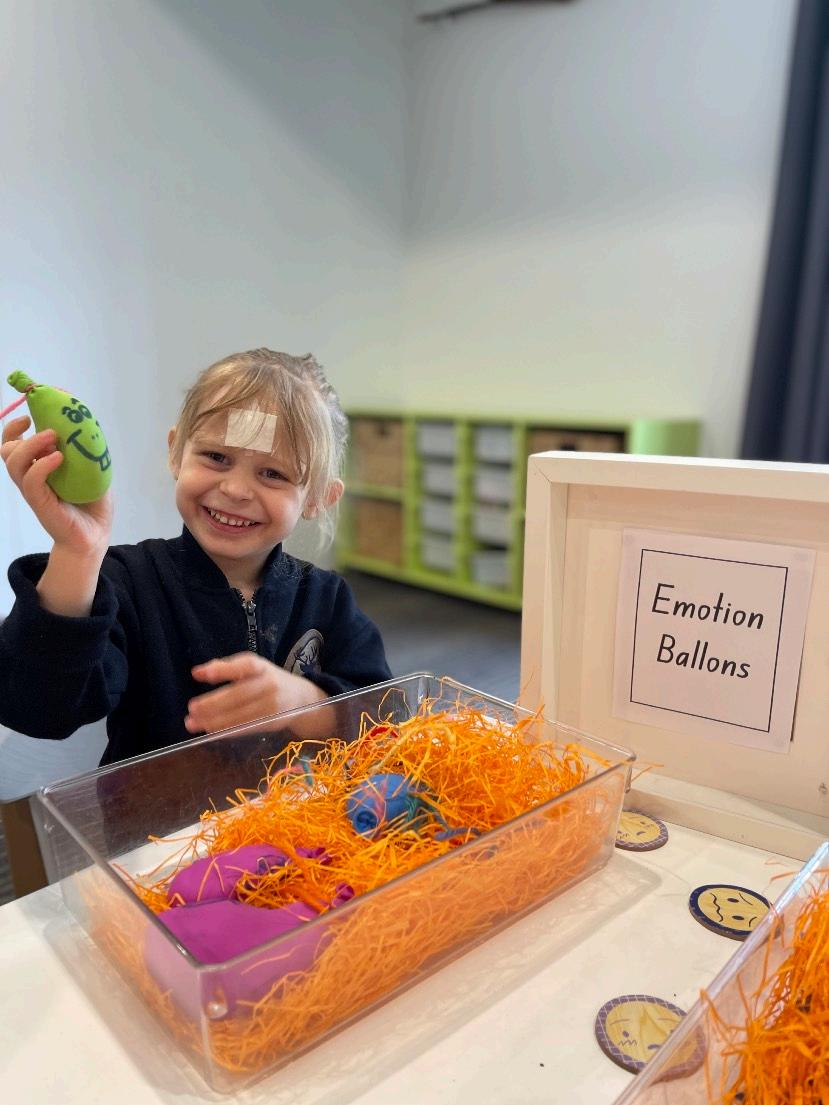
27
Stage 2/3: Fishing Emotions


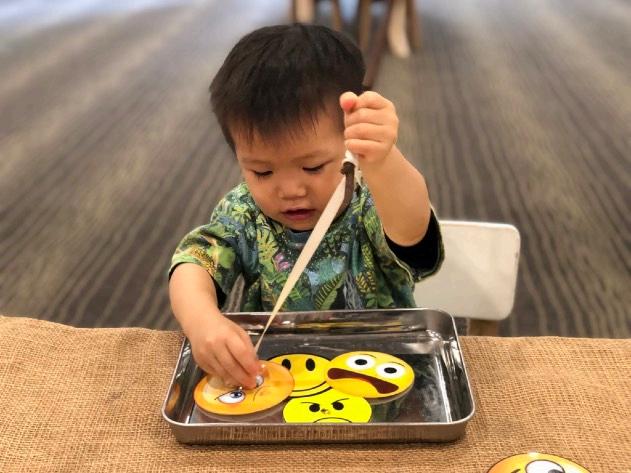


REDDAM EARLY LEARNING SCHOOL | ST LEONARDS NEWSLETTER 28
Stage 2/3: How Are You Feeling Today?


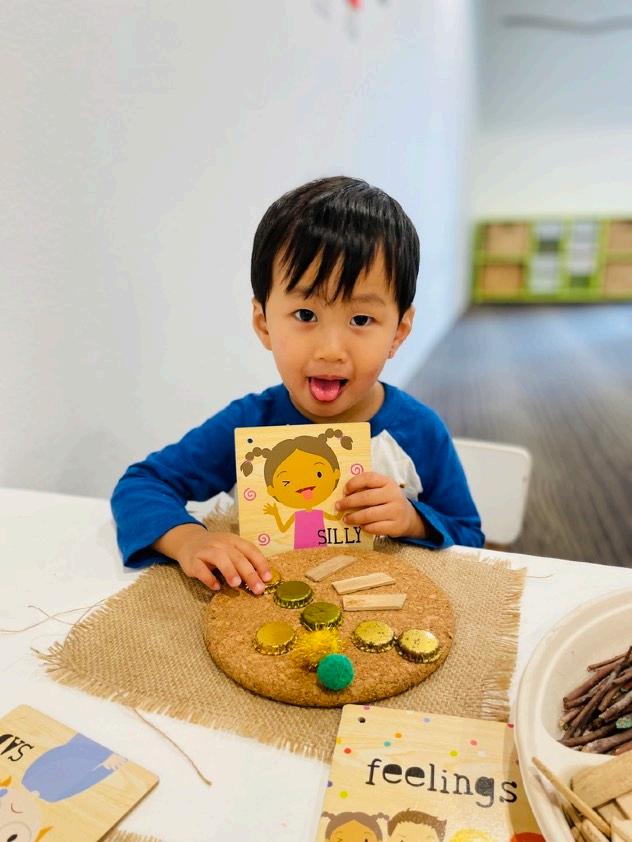
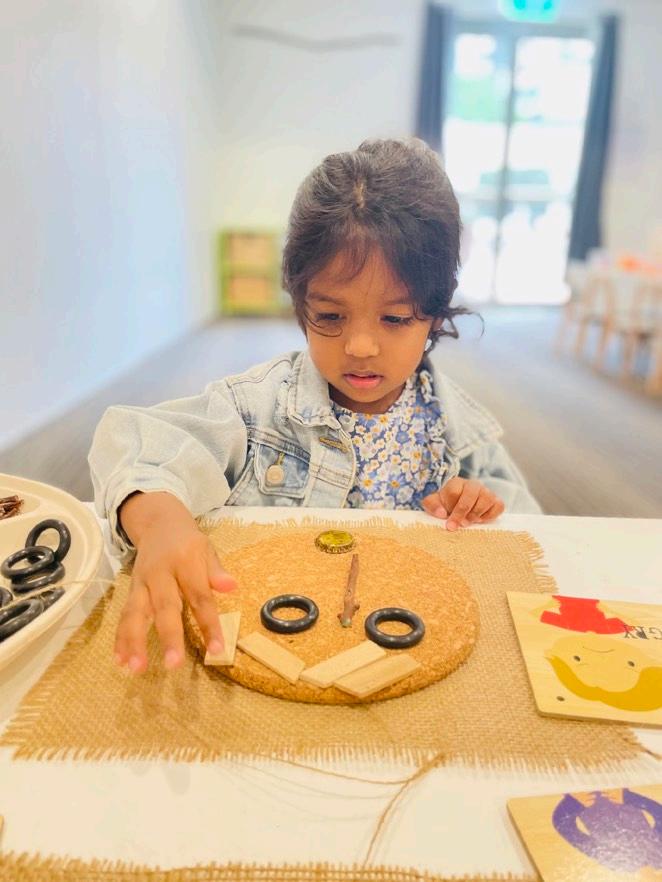
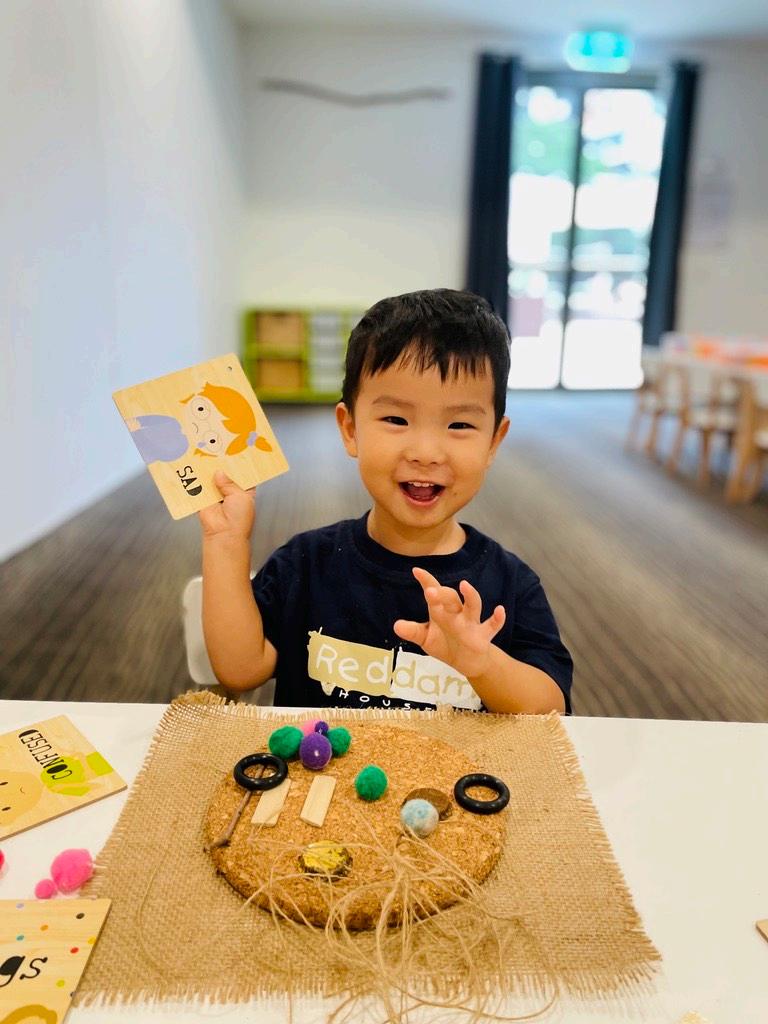
REDDAM EARLY LEARNING SCHOOL 29
Stage 2E
By Ms Madeleine Grant
The children loved last week’s ice cream activity, so we wanted to extend on this interest by creating more food-based experiences for them to demonstrate their learned behaviours of preparing, serving, and sharing imaginative meals with each other!
J is for Juice
In the art atelier the children made watercolour paintings inspired by (and using) fruit! We cut up some oranges, lemons and limes, and dipped them in orange, yellow and green ink. The children were shown how to squeeze out the excess juice, and press the fruit firmly on their page to create a detailed imprint of the sections. As they pressed we observed juice squeezing out of the citrus, and explained to them that this is how juice is made. As they painted we asked them to examine the citrus, and use their senses to think about how it looked, smelt, and felt.
K is for Kitchen
The children have loved our classrooms kitchen corner, so this week we brought it to the front of the room and extended it to a full dramatic play experience. Through this we wanted to encourage role playing and using actions and language that they had picked up from their daily lives. It was wonderful to see them navigating the space together, exploring the range of toy foods and utensils, and recreating actions such as chopping the vegetables, putting together sandwiches, stirring pots, and Lucas even made cappuccinos!
L is for Letters
The children were invited to do an activity that focused on their fine motor and preliteracy skills, by acting out writing and posting letters. They were given letter paper and a range of markers, as well as a big red post box. We asked them who they wanted to write their letter to, as the purpose of letters is to communicate through writing. Most answered either Mummy or Daddy, but some had other ideas. Kano wrote to Yuno, Aurora wrote to Esha, and Esha decided to write a letter to herself! While the children are still a developmental stage away from starting actual writing, we wanted to encourage them to practice controlled and intentional drawing techniques, and to think about where they put their pen and how they held it. Over the year we will continue refining their pre-writing skills such as letter formation and proper grip, so this activity was a great starting point to assess where each child is and how to best support them as they transition to the next stage of literacy development.
Wishing you a great weekend with your beautiful children, and we’ll see you next week as we explore the letters M, N and O with the moon, numbers, and outer-space!
REDDAM EARLY LEARNING SCHOOL | ST LEONARDS NEWSLETTER 30

REDDAM EARLY LEARNING SCHOOL | ST LEONARDS NEWSLETTER 31
Stage 2E: Juice Paintings and Kitchen Play
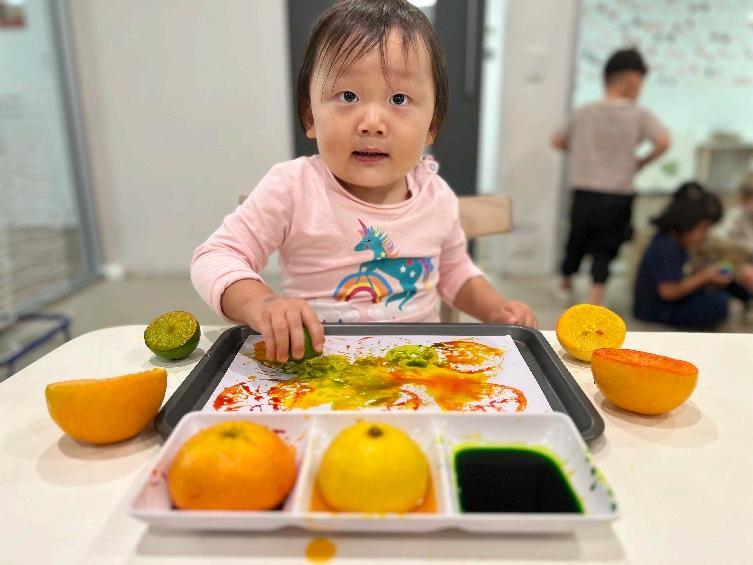

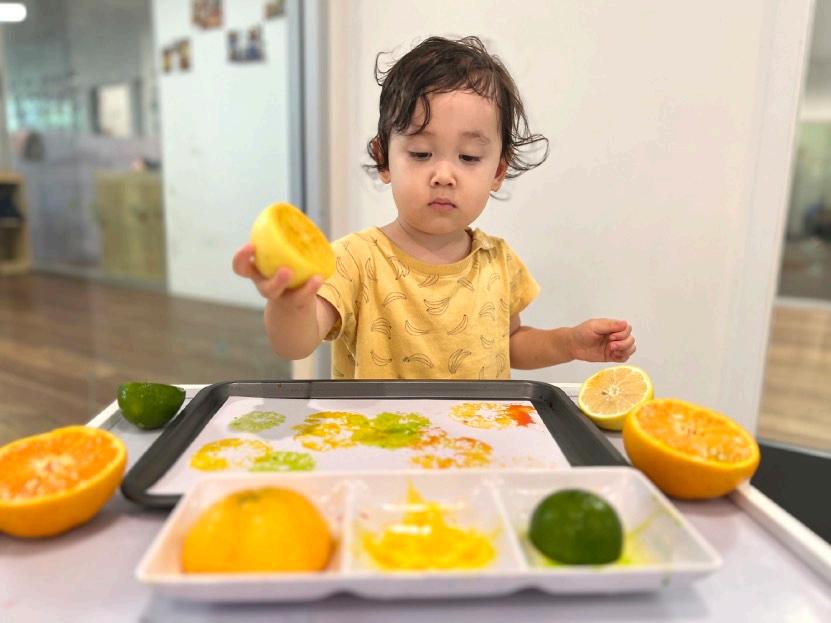


REDDAM EARLY
LEARNING SCHOOL
Stage 2E: Writing Letters


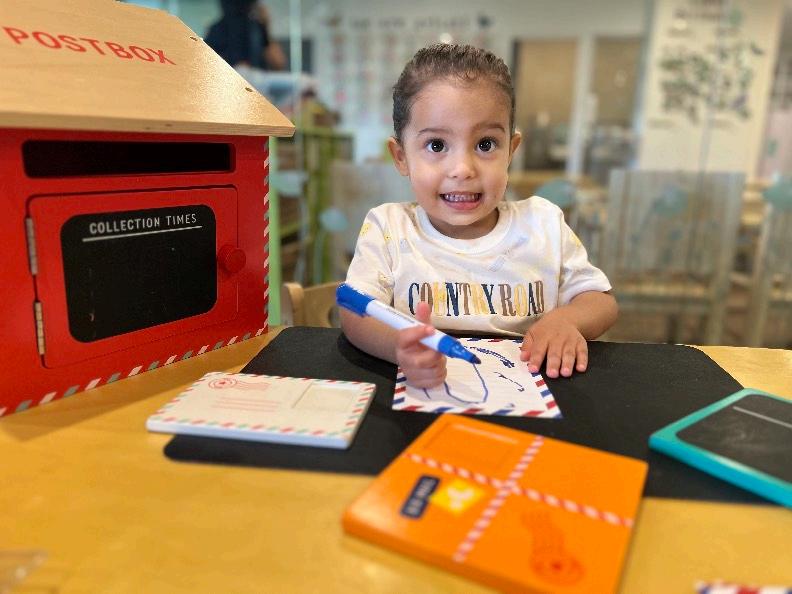
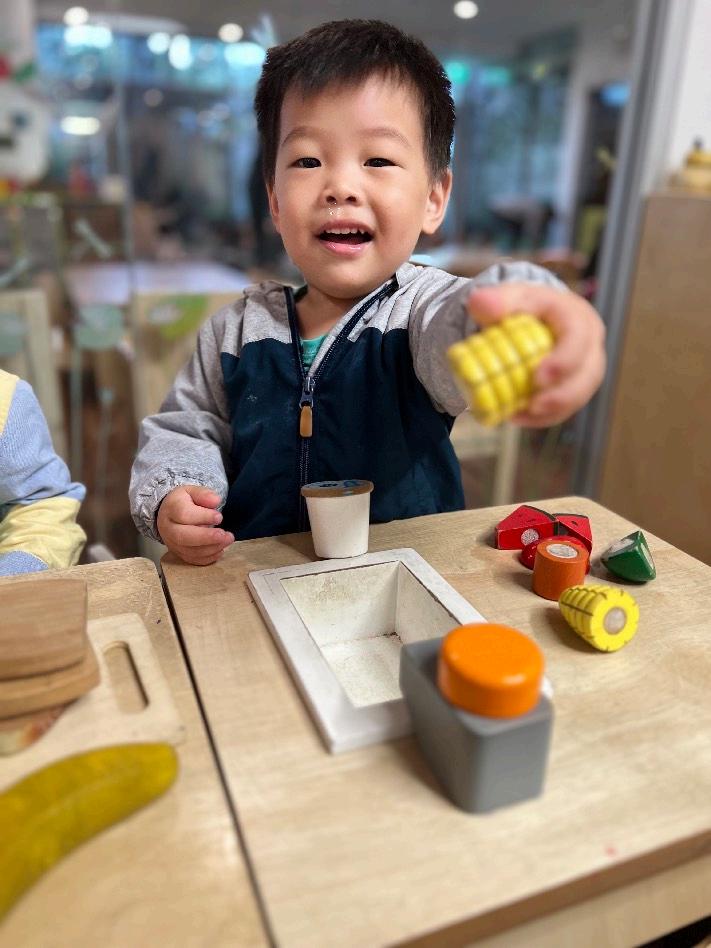
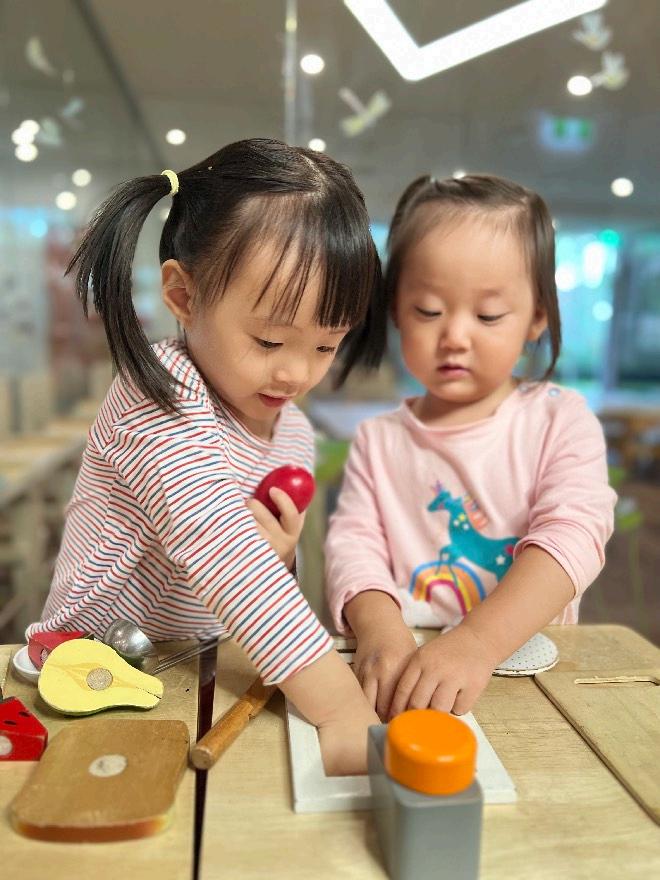
REDDAM
EARLY LEARNING SCHOOL
Stage 2R
Exploring Alphabet Provocation
G is for Gardening
By Ms Ailene Caballes
“There are no gardening mistakes, only experiments”
-Janet Philips
Providing children with learning opportunities to connect with the natural learning environment instils a love and respect for nature during their foundational early years and development. Academic research has shown overtime that children who form a loving and respectful relationship to nature and mother earth during their early years grow up to be happy and connected to their world.
Throughout our school we have many plants that we care for, therefore Ms Ailene planned and implemented the “G is for Gardening” provocation to show and encourage the children to care for the natural environment. The children were encouraged to use their gentle hands to touch our plants and feel how soft and smooth the leaves are. The children learned to collaboratively work with one another to share the space and gardening tasks and tools. They were very patient with one another and reminded each other of our “Sharing is Caring” kindness rule.
H is for Heart
“Every Child is an Artist”
-
Picasso
In our Stage 2R indoor learning environment, we have set up learning stations for the children that change daily according to the interests of the children and one observation we made is that the children enjoy playing with our magnetic shapes and tiles to build their unique creations. One of the shapes that the children often enjoying playing with is the heart shape. Therefore, Ms Ailene decided to plan and implement a provocation that prompts children to explore the heart shape through art.
Painting is a creative platform that can be utilised to inspire creativity and imagination amongst children. Painting can also help develop their fine motor skills as they exercise their pinch and grip form when using painting tools. It is a creative platform that builds on the children’s STEM skills and knowledge as they mix colours together to create a new colour or hue altogether.
Next week, the Stage 2R children will be exploring the letter I and letter J in our fun-filled provocations!
REDDAM EARLY LEARNING SCHOOL | ST LEONARDS NEWSLETTER 34

REDDAM EARLY LEARNING SCHOOL | ST LEONARDS NEWSLETTER 35
Stage 2R: G is for Gardening
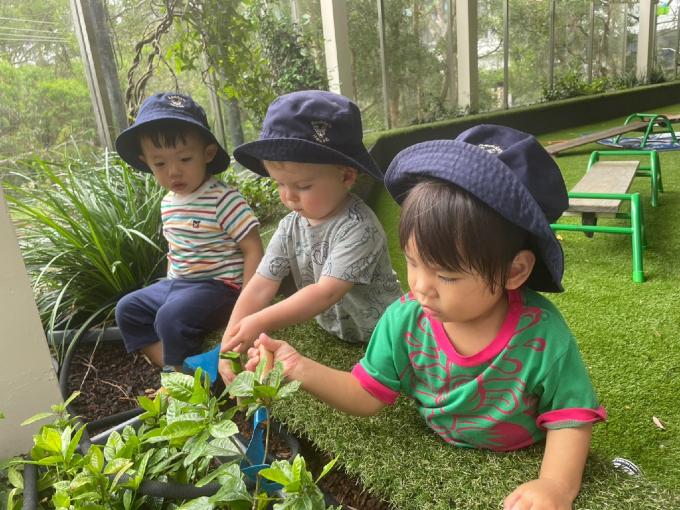
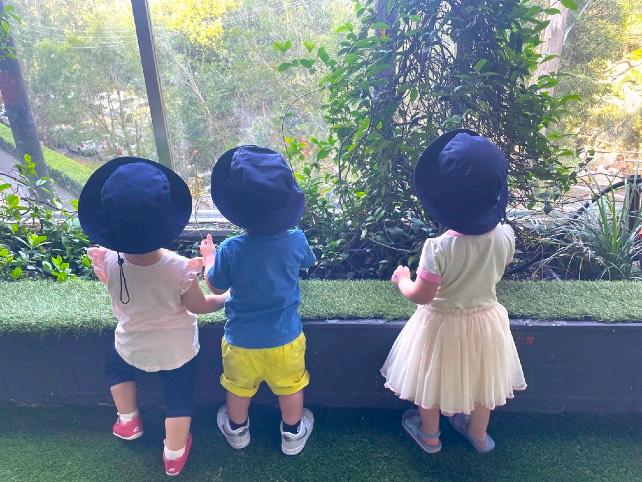

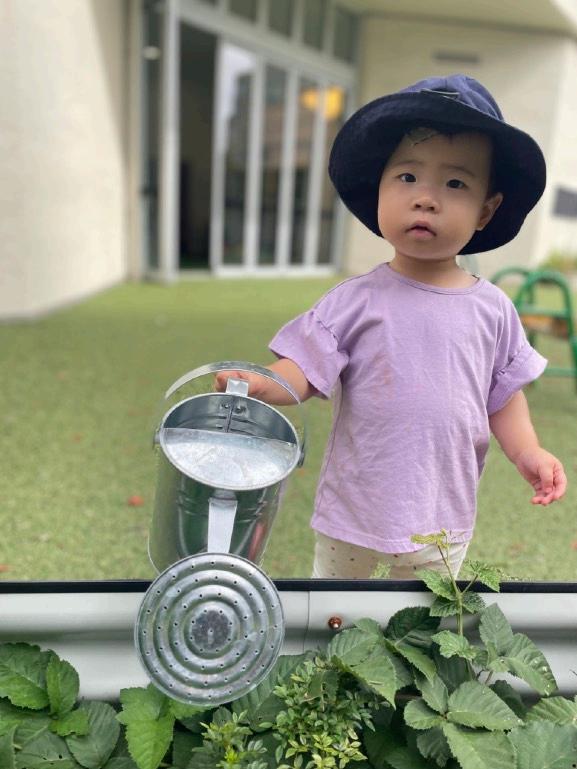

REDDAM EARLY LEARNING SCHOOL | ST LEONARDS NEWSLETTER 36
Stage 2R: H is for Hearts

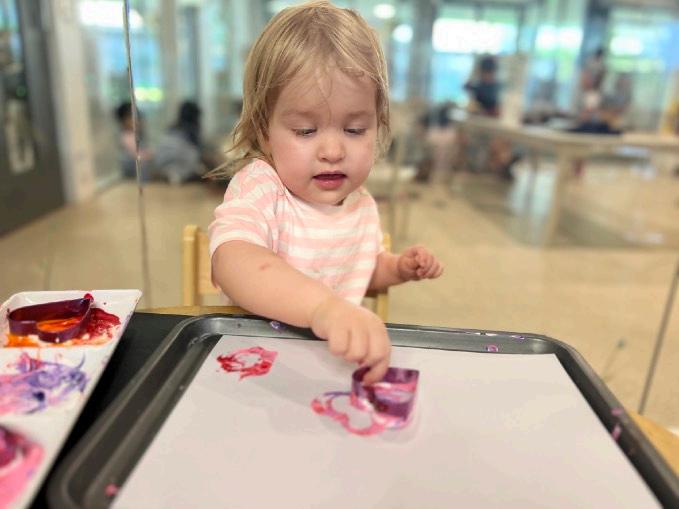
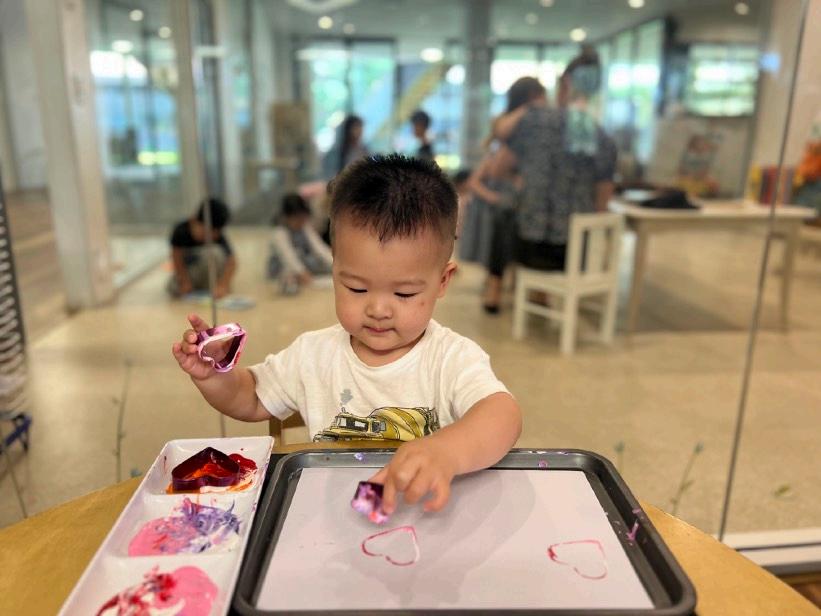
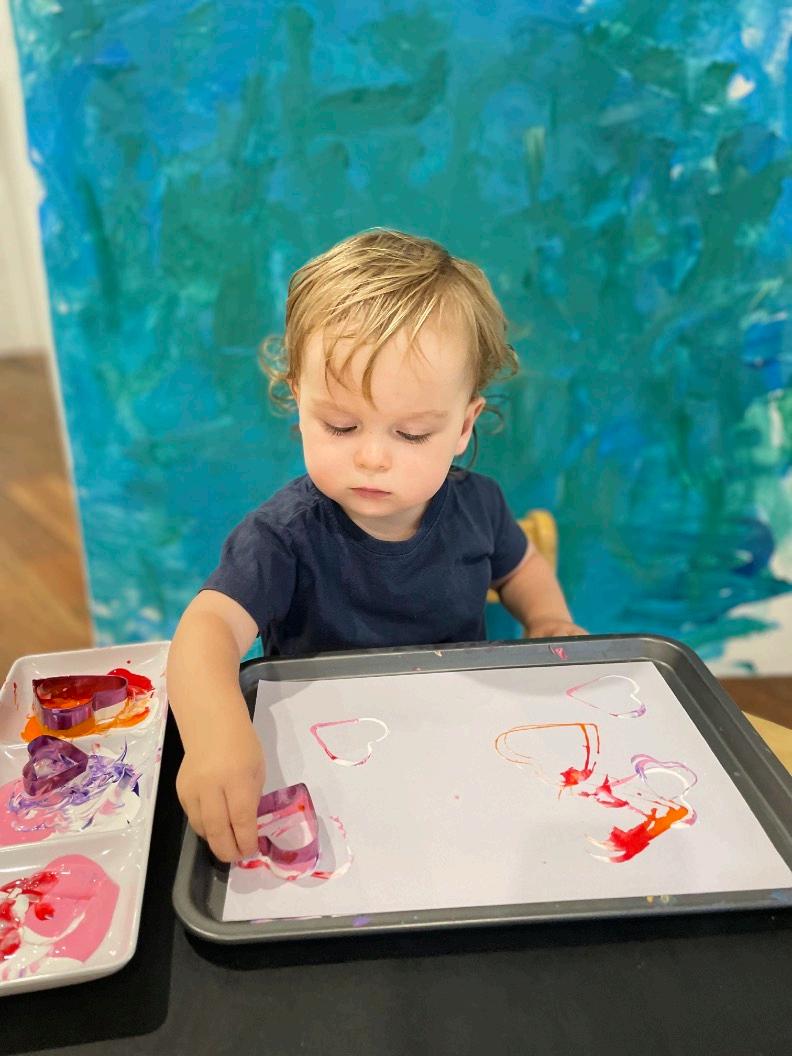
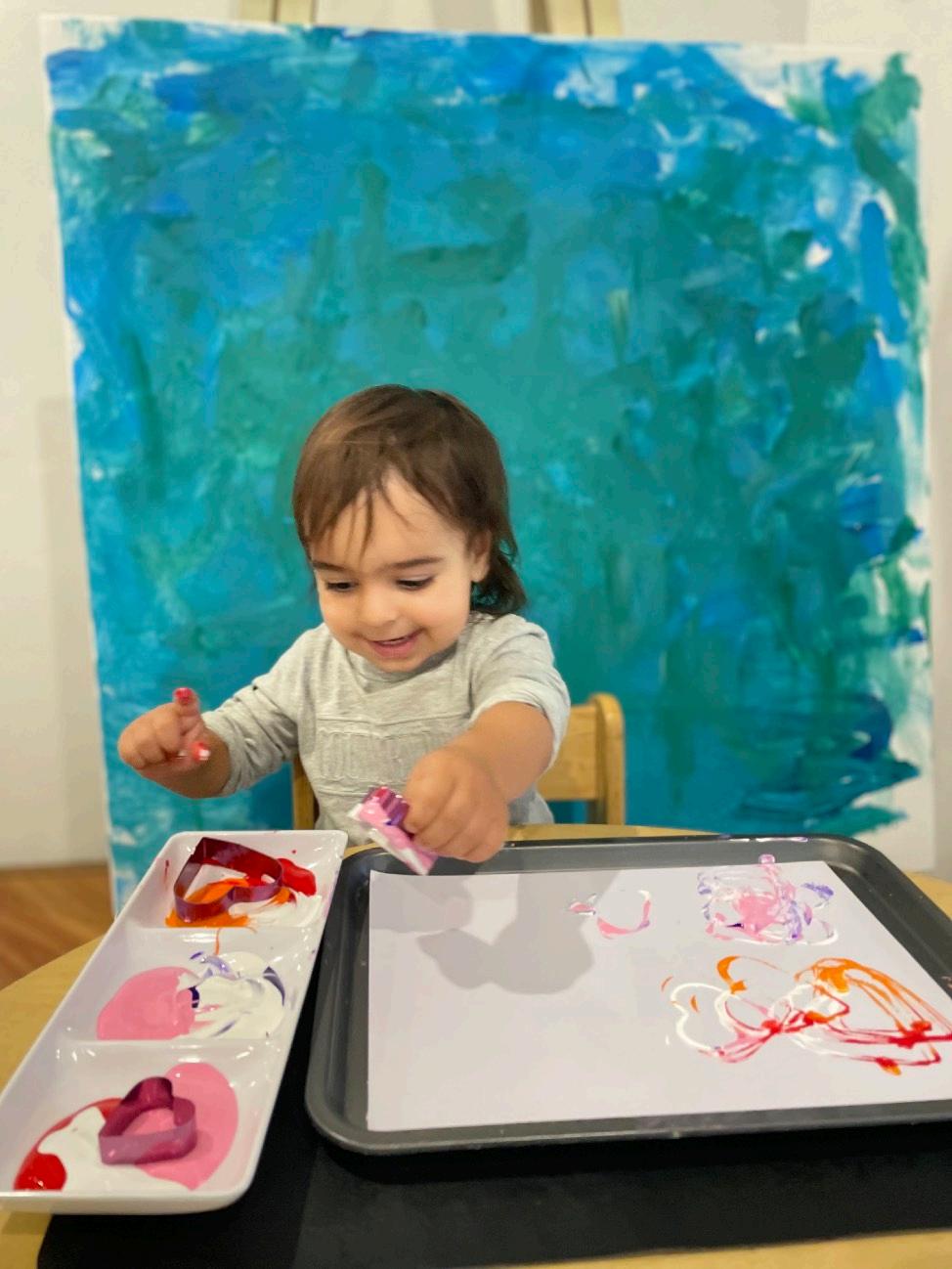
Stage 1E
By Ms Alessia Angilletta
“Children are like wet cement: whatever falls on them makes an impression.”
– Haim Ginott
This week the children enjoyed our last week of “under the sea” provocation, the activities included Fish in ocean goop sensory tray, water fun with sea creatures and sea animals jumbo ice, and for art ice fish cubes.
The children enjoyed these provocations very much as well as the topic, the fish in ocean goop was great as it really stimulates the children’s focus and fine motor skills and it's a great tactile sensory experience, it also promotes mindfulness, encourages them to play independently and is calming.
Some were happy to explore it using their fingers, some used sea creatures and got them to take a deep dive in the goop ocean.
The jumbo ice activity was a great link to support the children’s fine motor skills, as the ice melted it made it harder and harder for the children to grab a hold on the ice, it was also stimulating for them to feel the different temperature.
The water with sea animals was also so much fun for the children, they all love water play so we felt that adding this option now while the weather is still nice and warm was a great idea.
This activity was done outside in our beautiful playground so that other children could stand by and watch other friends having their turn, this was a great way for the bond and create friendships and also for them to develop patience as they waited for their turn, the water had some blue sparkles in it and the children were captivated by it and also gave us the opportunity to work on colour recognition.
Art was focused on using ice, we noticed how intrigued the children were by the coolness of the ice and so we decided to use that as part of the art, the ice cubes were shaped like a fish to link back to the provocation and were coloured orange, yellow and red to mimic the colour of our pet fish Harry.
Stay tuned, next week we will focus on mini-beats.
REDDAM EARLY LEARNING SCHOOL | ST LEONARDS NEWSLETTER 38
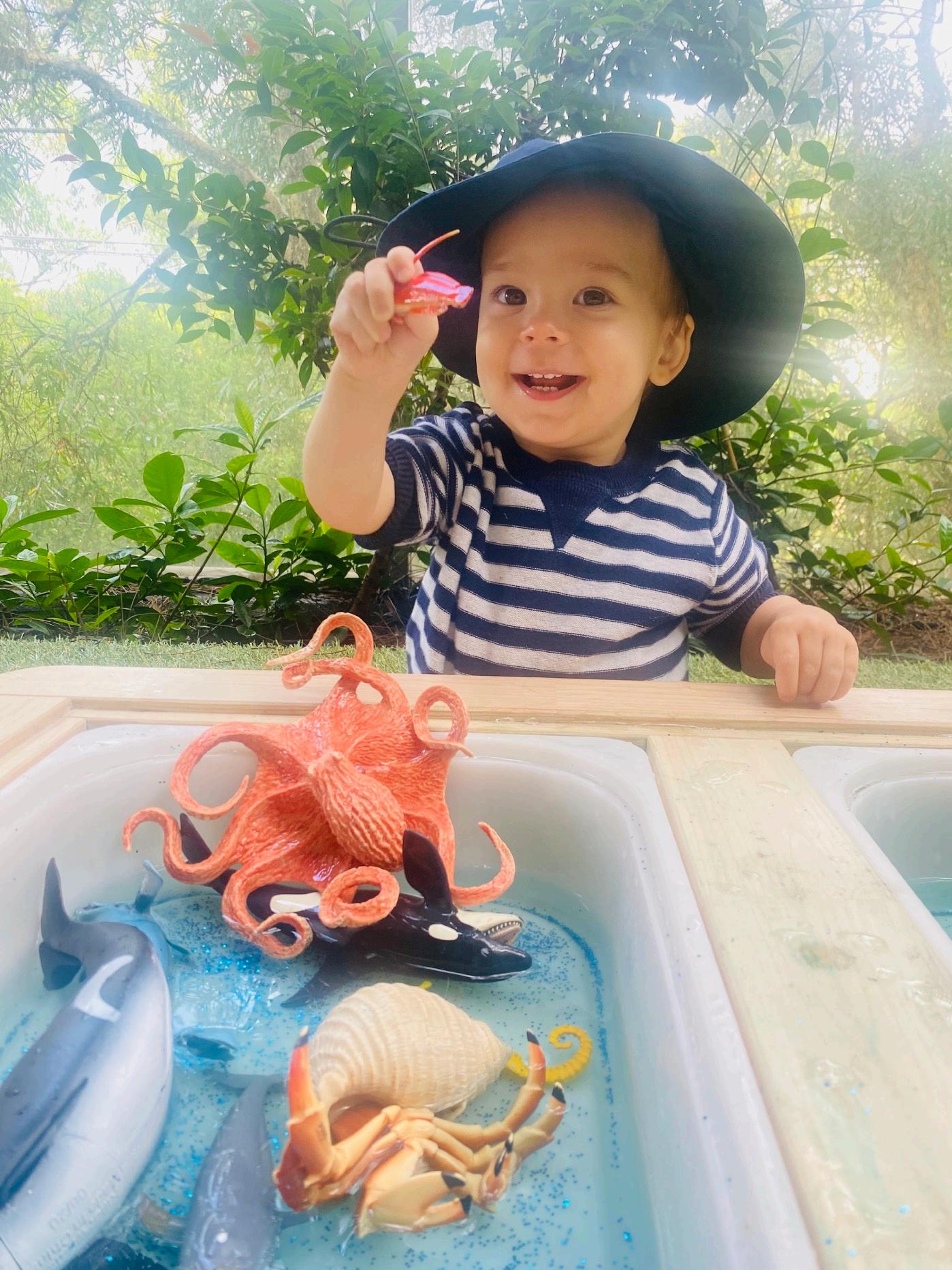
Stage 1E: Ocean Sensory
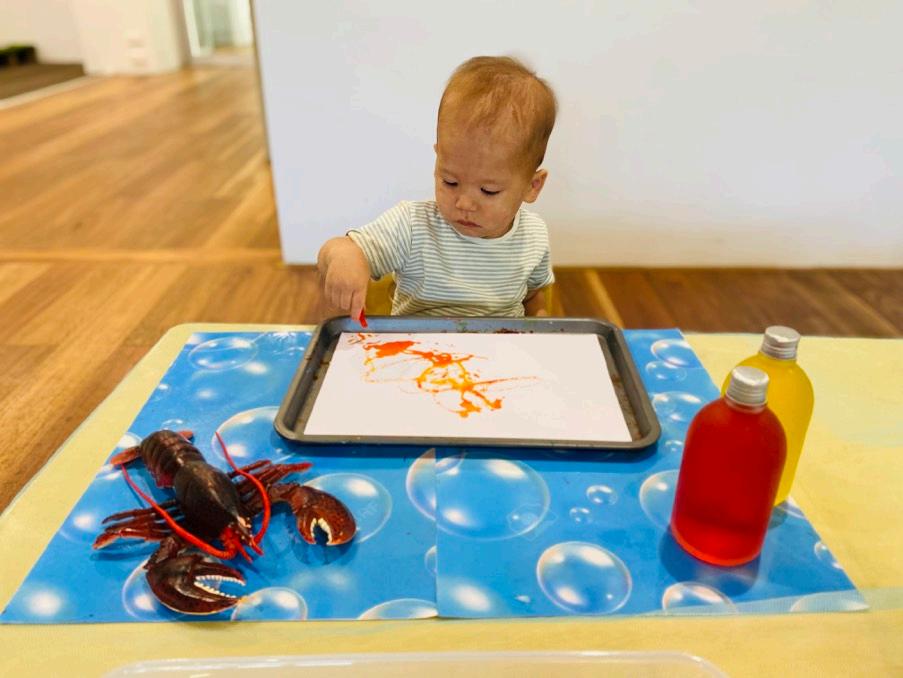



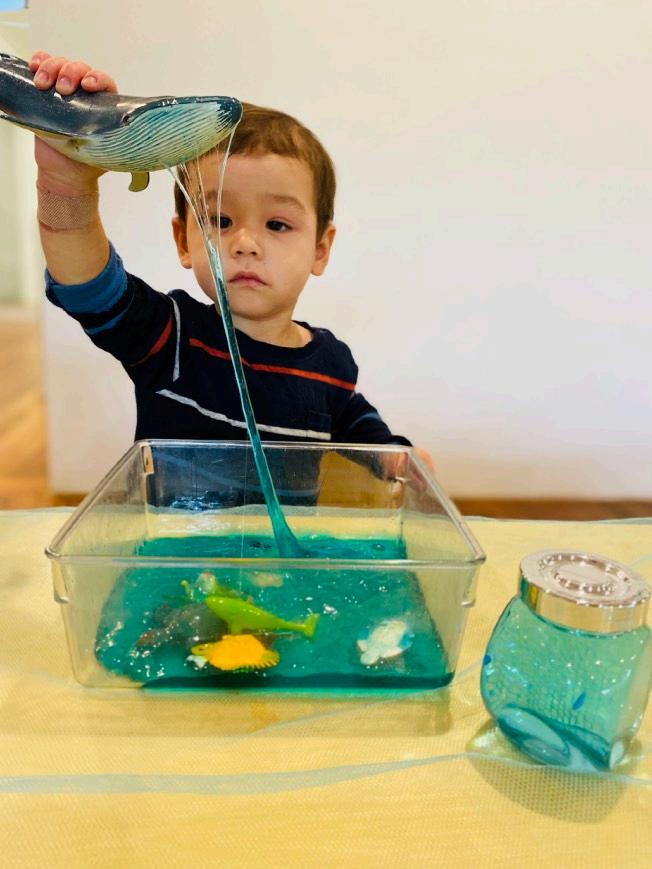
Stage 1E: Animal Ice Rescue
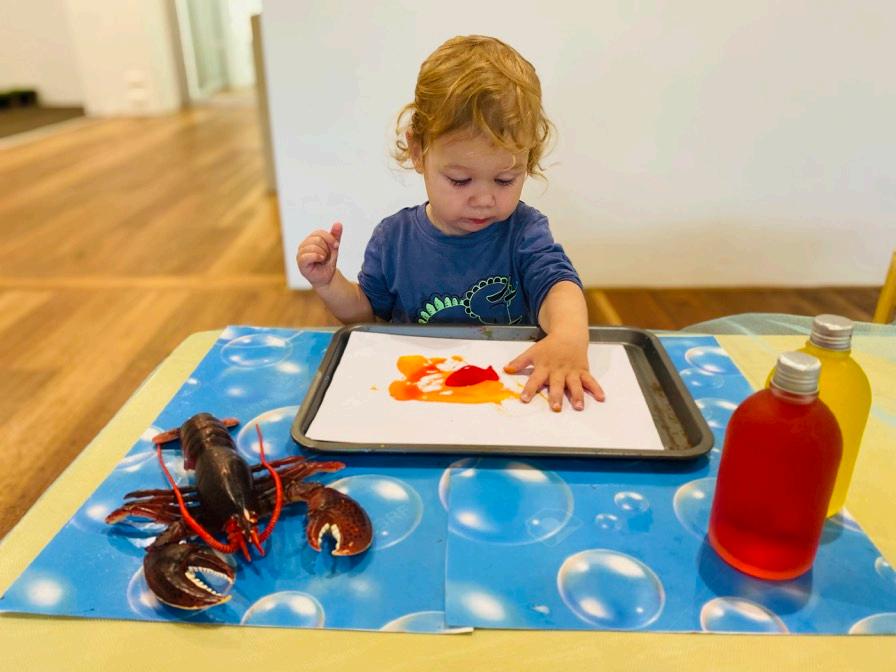
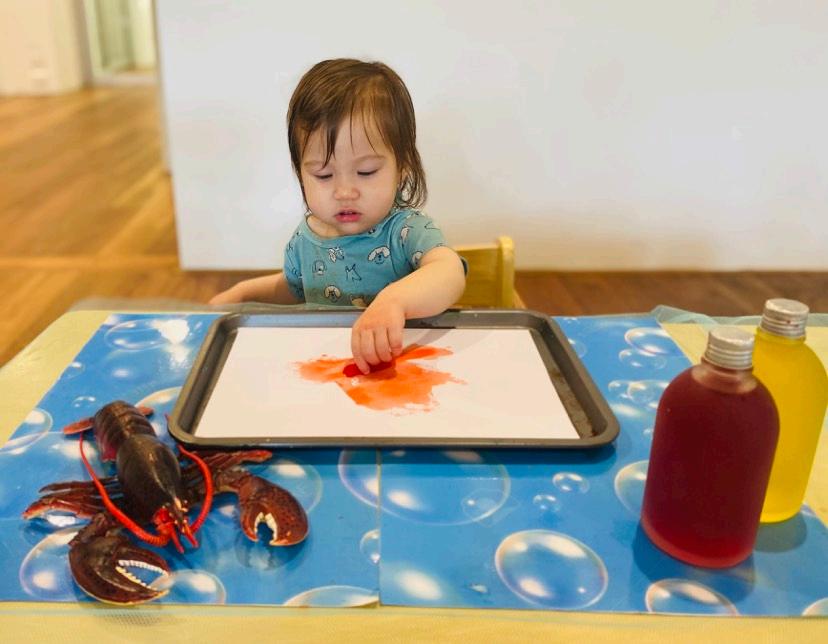


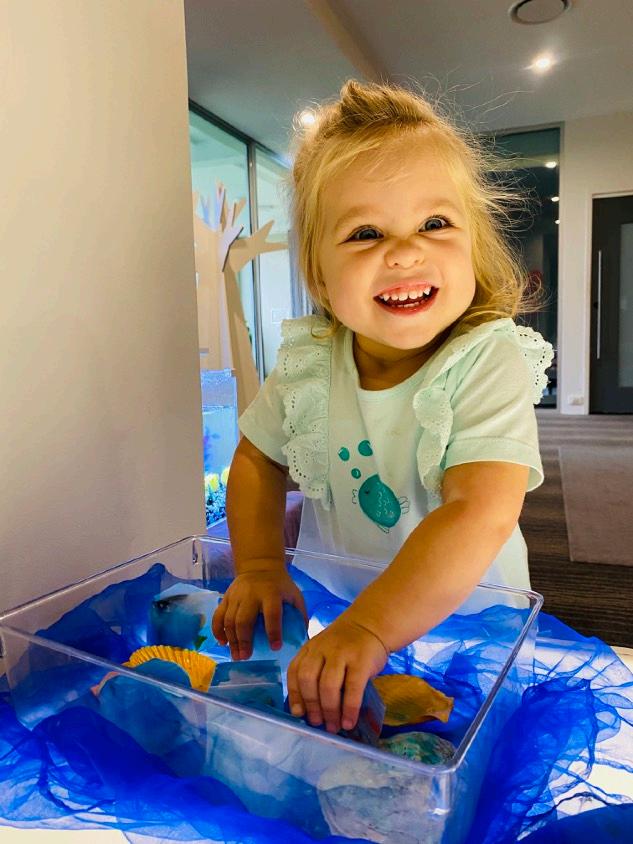
REDDAM EARLY
LEARNING SCHOOL
Stage 1R
By Ms Amanda Felton
We do lots of singing of Jack and Jill nursery rhyme. “Jack and Jill went up the hill to fetch a pail of water..”
With splashing on water and moving the figurines around in the sensory tub was so much fun for everyone.
All the Babies display wonderful share and taking turns skills. Great teamwork everyone!

The painting was also fun as it was also a sensory experience for artwork. Each Baby had to roll the ball across the paper to show a print, which represents water.
All the Babies did well to follow instructions from their teachers and showing a willingness to learn and enjoy the experience.
Drama class also was very engaging as the Babies experience and explore funny faces
42
Stage 1R: Jack and Jill


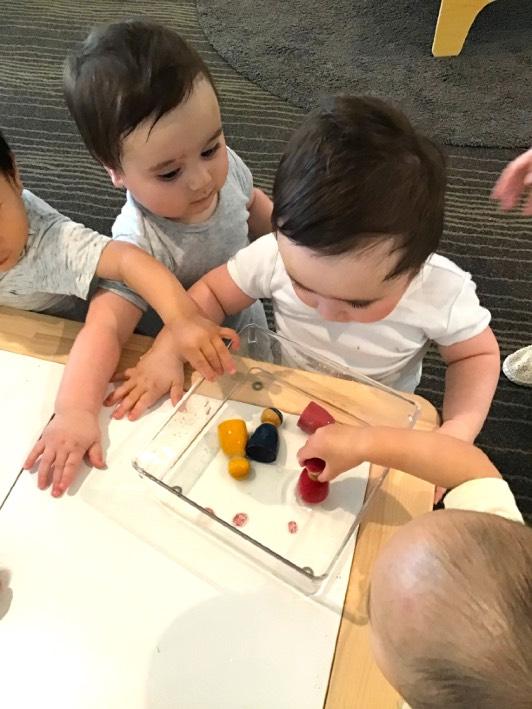
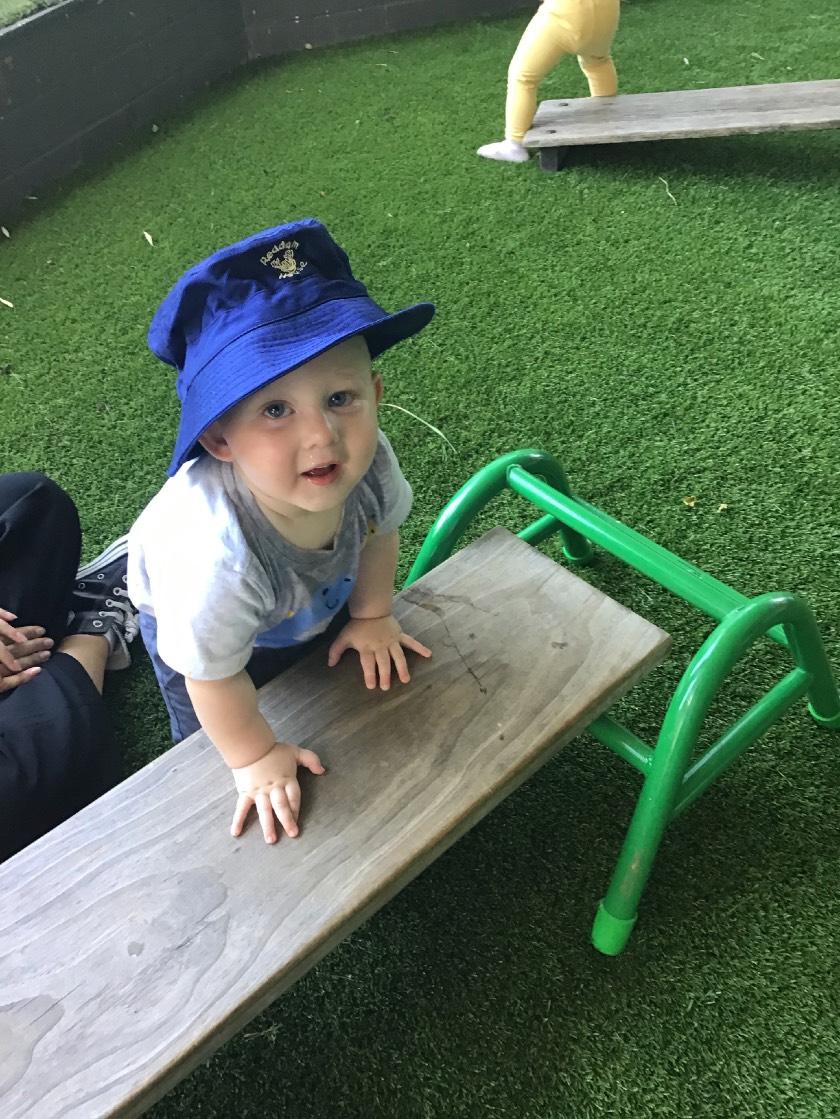

43
Drama
By Ms Laura Hudson
This week I thought it was important to establish what drama is as we often get asked this by some of the children. So, with the older children we discussed What is acting? What types of acting do people do? Movies, television, theatre. What is theatre like? How is it different from television and movies? Do you want to be actors today? Actors must practice, and they play games to practice being good actors.
In the younger years (downstairs) The first activity we did was “the floor is”. We started a discussion about how we use our imaginations to pretend. We are going to pretend the floor isn’t the floor. The floor is... honey, ice, a giant trampoline, spiky, hot.
Then we started to pretend that we weren’t ourselves. I got everyone to line up and walk from one side of the room to the other as different characters we might meet over the term: a doctor, an astronaut, teacher, superhero, Lion and kite.
We then danced to ‘Let’s Go Fly a Kite’ from Mary Poppins using the ribbons and pretending they were kites. We had some wonderful shapes, Well done Aydan from the babies and Amelia from Stage 2/3 they danced wonderful and followed direction really well!
In Stage 3 and 4 we started by playing pass the Ball: All the children stood in a circle. The children then passed a mimed ball to others quickly. When it came back to me, I changed the ball in some way: it became heavier, until it weighs a ton, or extremely light, extremely big (and light or heavy) or extremely small (and light or heavy). The ball can take on other characteristics (or adjectives) such as hot, cold, etc. The children needed to show the ball's
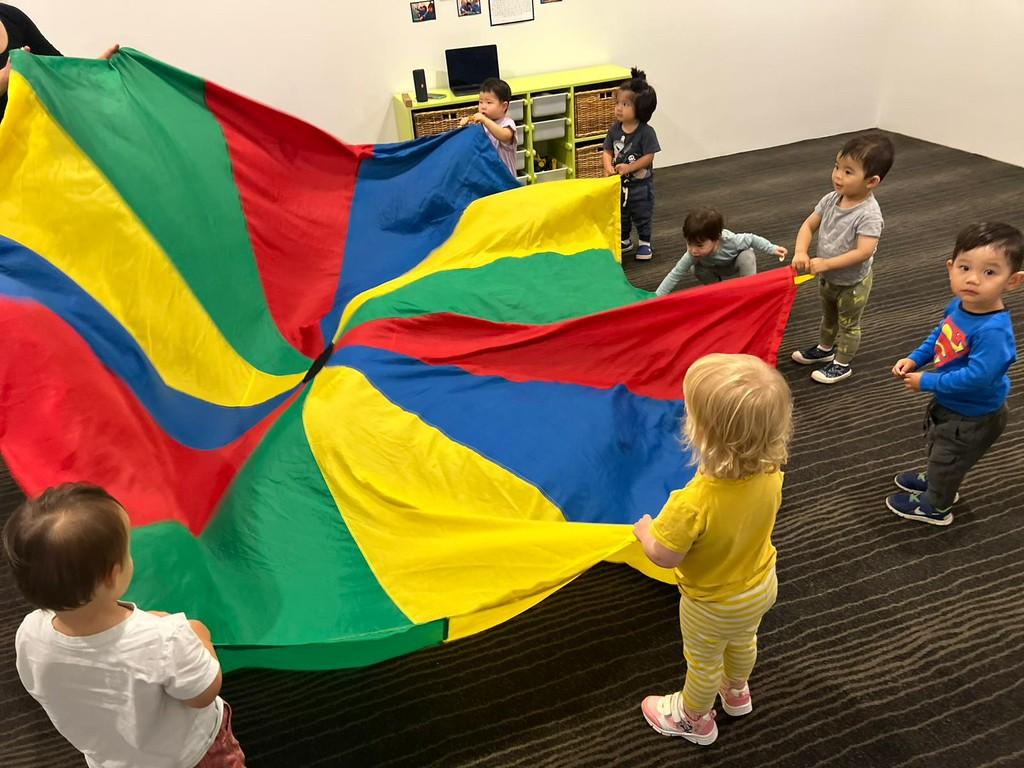
The importance of this game is to be aware of other actors. Good actors can work with other actors and learn to react to what they are doing.
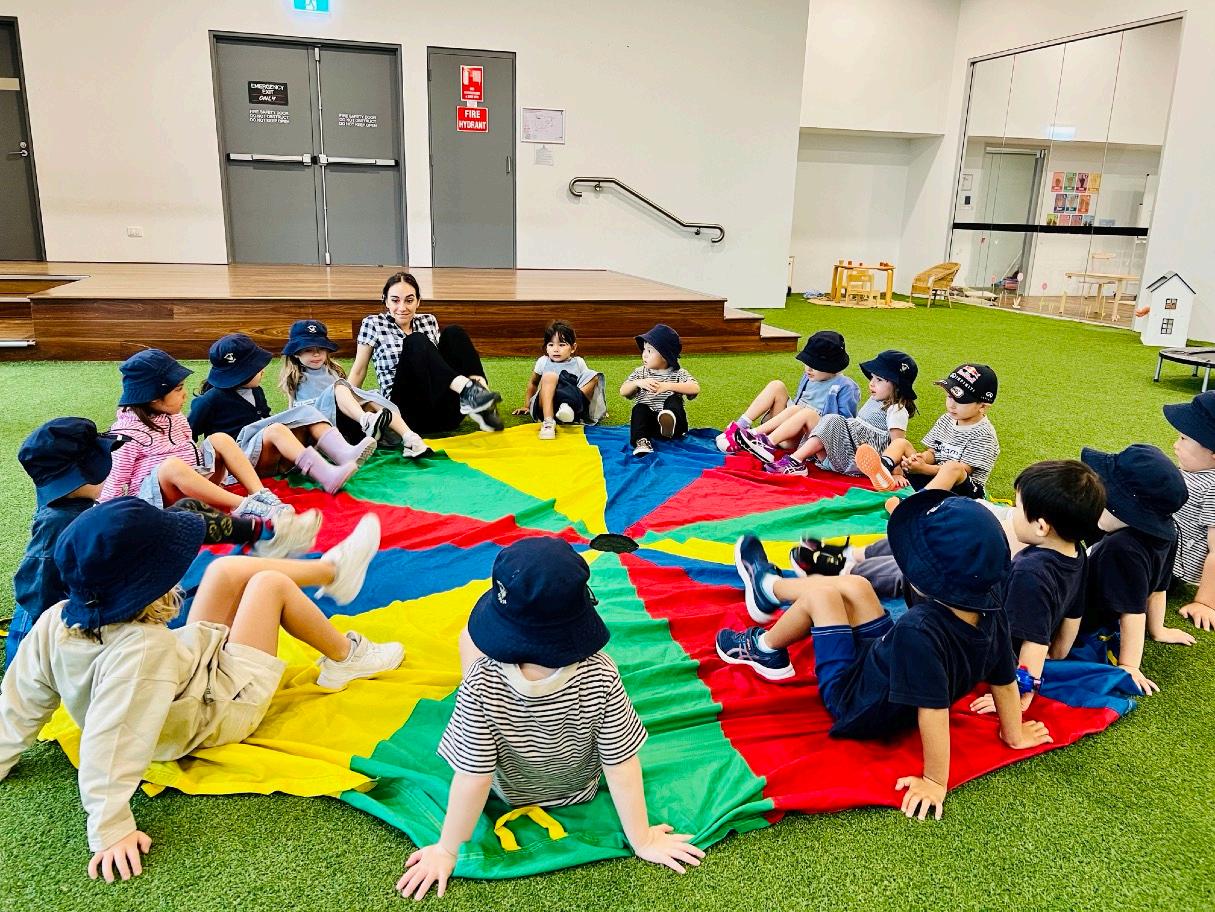
We also did a character and freeze exercise. Everyone quietly mills about the room. When I shouted freeze, then everyone must stop. After doing this a couple of times I froze in position unexpectedly and did not say freeze. As soon as one notices I had frozen in position they freeze as well. So, the effect of one person freezing causes everyone to freeze. Once everyone is still, the group starts milling around again. The goal is to see how quickly the group can freeze in position. Once the children get the hang of it, then I had everyone close their eyes. I tapped a child on the shoulder and that child became the secret leader. Everyone opened their eyes and then started moving around the room. The secret leader freezes and everyone must freeze. The other students then guess who the secret leader was. If they can’t tell, then everyone starts again and tries to figure it out.
Shrinking Box: children pantomine that they are in a very large box. At first, they might think it is fun and get excited. The children show that emotion. Then they might get mad and show that emotion. Then they might get sad and cry. Then the box gets smaller. They find the sides of the box and then show the same three emotions again. The box shrinks a
REDDAM EARLY LEARNING SCHOOL | ST LEONARDS NEWSLETTER 45
Drama
Piano
By Mr Alan Tang
This week is the second week of piano lessons at St Leonards Reddam, and the children were taught how to read, find and play the middle C with their thumb.
Stage 4 was a group of fast learners. Using the thumb to press the key seems very unnatural for many, because of my finger anatomy, we often automatically use our index finger right away. Under encouragement and guidance, the children were starting
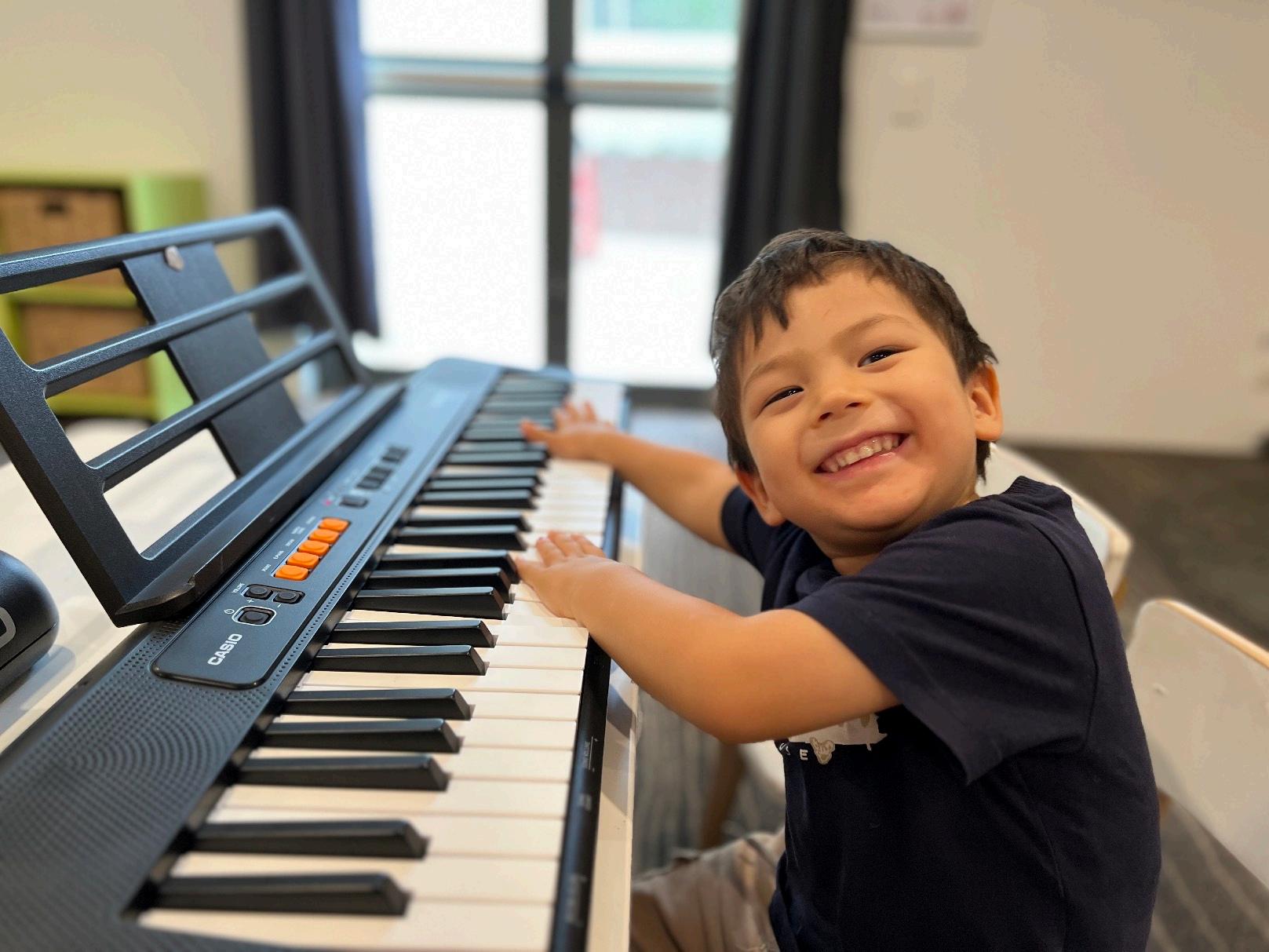
REDDAM EARLY LEARNING SCHOOL | ST LEONARDS NEWSLETTER 46


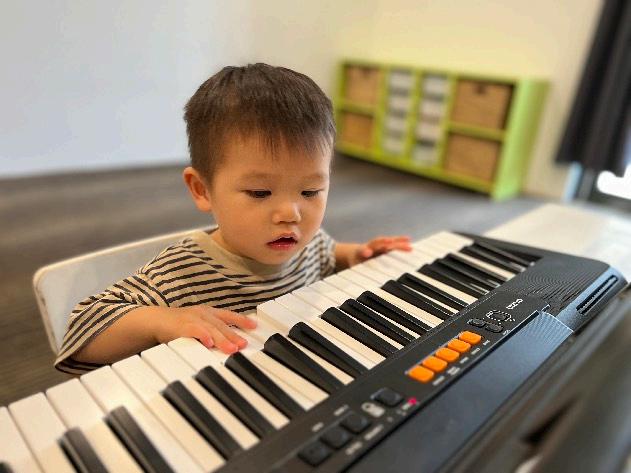
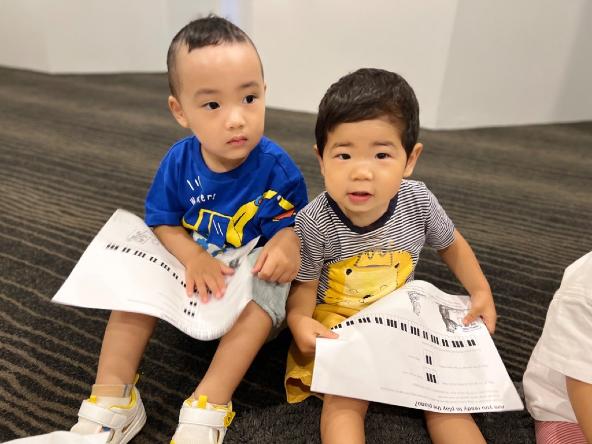

REDDAM EARLY LEARNING SCHOOL | ST LEONARDS NEWSLETTER 47
Piano
My Gym

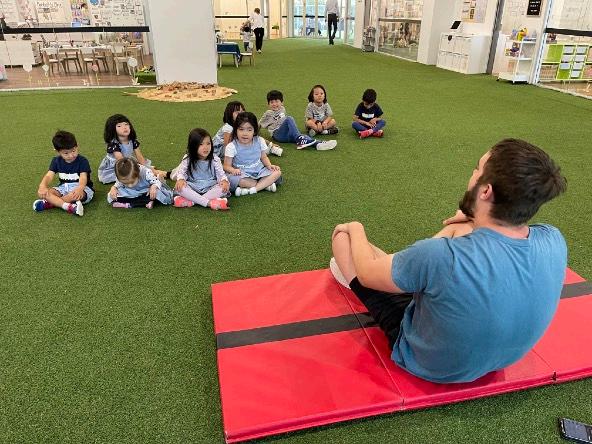
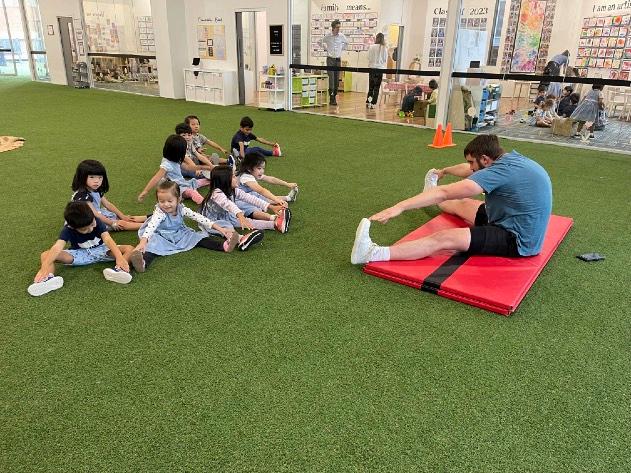

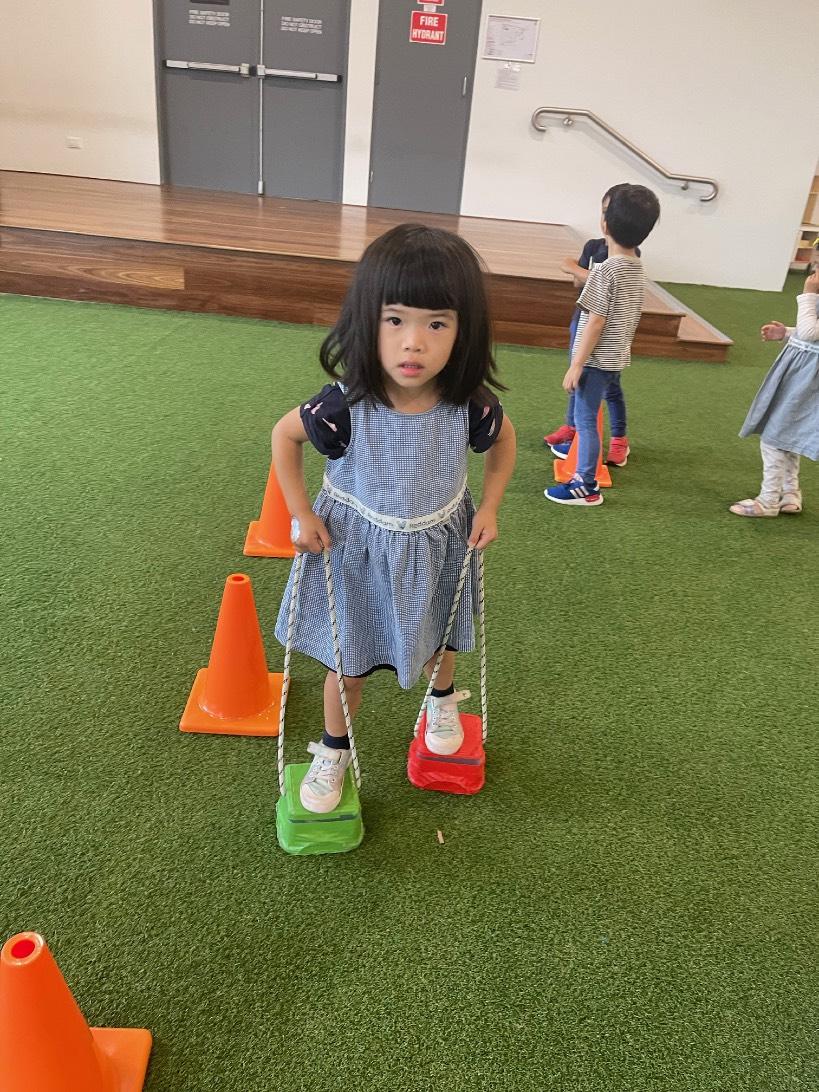
REDDAM EARLY LEARNING SCHOOL | ST LEONARDS NEWSLETTER 48




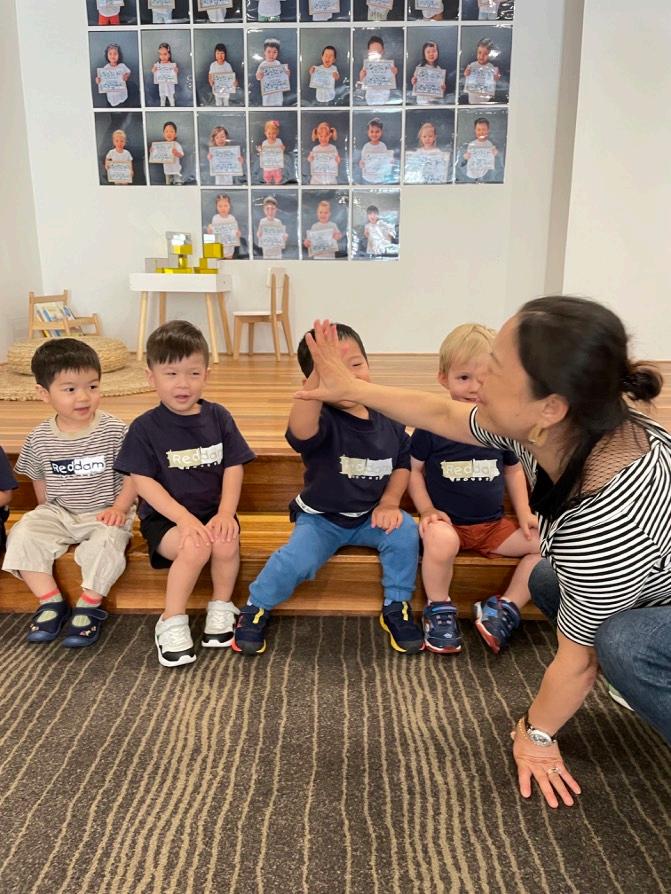
49 Mandarin
 By Mrs Simone Cooke
By Mrs Simone Cooke
 - Loris Malaguzzi
- Loris Malaguzzi















































































































































